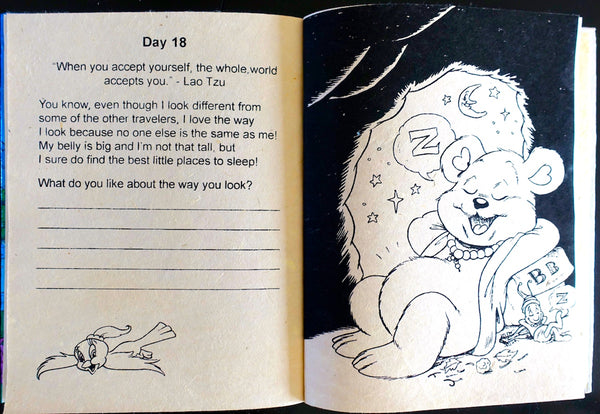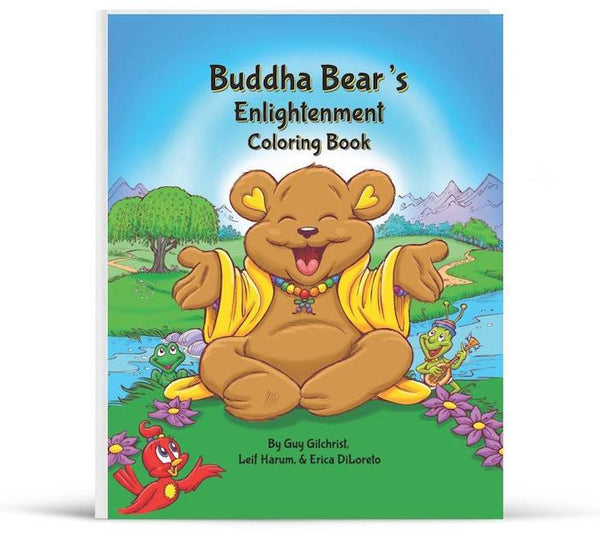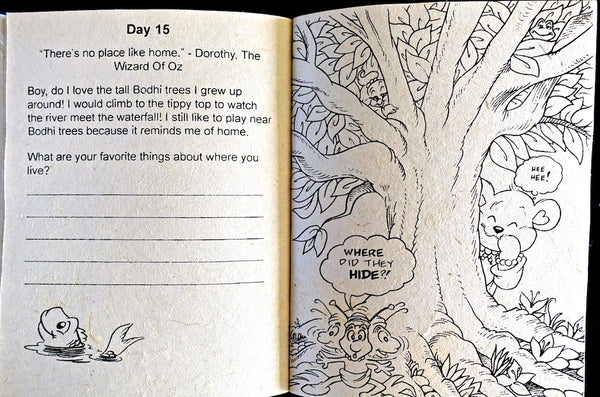Enlightenment Blog
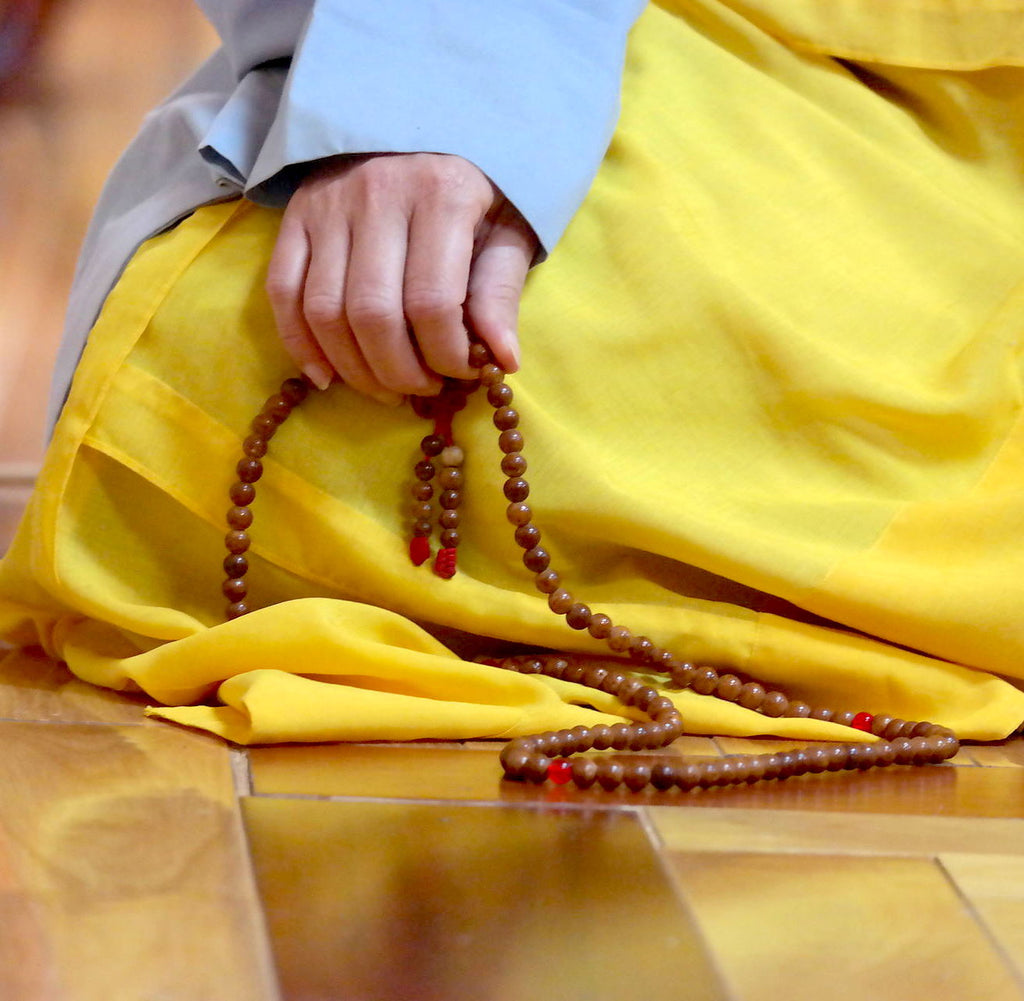
How To Meditate With Mala Beads: A Comprehensive Guide
What Are Mala Beads?
Mala beads are an overarching term for Buddhist prayer beads. The name itself stems from Sanskrit, and literally translates as “Heavenly Garland.”
Their origins date back nearly 3,000 years to the formation of what is now modern day Hinduism. Today Mala beads are commonly used in Tibetan Buddhism, and throughout the various sects and schools of Buddhism.
Mala beads are comprised of 108 beads and a larger guru bead.Traditionally, Mala beads are used during meditation and prayer, with each bead symbolizing a mantra, prayer or affirmation.
Practitioners hold the Mala beads in one hand and use the thumb to count each bead as they recite their mantra or prayer. The larger guru bead marks the end of the Mala and signifies the completion of the practice. The repetitive physical and mental act of counting each bead is believed to help still the mind and deepen the meditative experience.
In modern times, Mala beads have become popular not only for their spiritual significance but also for their aesthetic beauty, with many people using them as a reminder to stay focused and present in their daily lives.
Why 108 Beads?
Although Mala beads often come in different bead amounts, most notably 72/54, the most commonly used is the Mala of 108 beads. While the reason for 108 beads is contested, it is a spiritually significant number found throughout Hindu and Buddhist traditions.
In Hinduism, there are 108 Upanishads, ancient texts from spiritual sages. There are also 108 revered Hindu goddess. In Buddhism, there are 108 earthly desires or 108 illusions that must be overcome to achieve enlightenment.
Finally, some people have found the number 108 significant in astrology where the multiplication of 12 houses and 9 planets equals 108. Whatever the case, there is no doubt that 108 beads holds great significance across Hindu-Buddhist religions.
Outcomes of Mala Meditation
Meditation with a Mala bead can bring a number of positive outcomes to your life, beyond the traditional benefits of meditation itself. Through the repetitive physical motion of using the Mala, the mind is allowed to focus and quiet, allowing for greater self-awareness and introspection.
Meditation with a Mala bead has helped countless individuals achieve personal growth and development. For example, many individuals struggling with addiction have found that incorporating Mala meditation into their recovery routine has helped them cultivate mindfulness and emotional regulation, reducing the likelihood of relapse.
For those searching for purpose in life, Mala meditation can provide a sense of calm and clarity, enabling them to better connect with their inner selves and desires.
Those processing grief have reported that Mala meditation has helped them find peace and comfort, while others struggling with anxiety have found that it helps them develop resilience and manage stress in a healthier way.
These are just a few of the many examples of the positive outcomes people have experienced through Mala meditation.

How To Choose A Buddhist Mala
When choosing a Buddhist Mala, it is important to consider a few different things.
- Bead Size: Whichever Mala you choose, you're going to want to make sure that the beads feel comfortable and even calming between your fingers. A good size for those with smaller fingers is 6 or 7mm round beads. For people with larger fingers, 8 to 10mm is recommended. Of course, this doesn't means 12 or even 14 mm bhodi seeds are out of the question, as many monks often count on these as well.
- Bead Texture: Some people prefer the energy transference of a metal Mala, the texture of a conch shell mala, or even the properties of crystal mala beads. Others find wooden mala beads the most satisfying to roll. And there are those that prefer prickly rudraksha seed Mala beads.
- Mala Weight: The Buddhist Mala is often adjustable and worn around the wrist. If you prefer something lighter, wood is your best option. For a more substantial feel, copper, brass, conch shell or crystals are preferred.
Overall, it's a good idea to test each type of Mala before committing. Discover which one speaks to you the most to and your unique energy. For a collection of wearable 108 bead Malas, you’ll find our collection here. We are big believers in karma, always offer returns, and strive to treat every customer the way we would want to be treated.
Why Choose A Blessed Mala?
In countries such as Nepal, the birthplace of Buddha, it is common to have a new Mala blessed by Buddhist monks.
The Wodechen Thuk-Je Choeling Monastery is one place where one can have their new Mala blessed. Here, blessings are done according to ancient Tibetan Buddhist tradition.
This monastery is located 365 steps above Kathmandu, in one of the most revered Buddhist temples in the world.
In the words of its modern founder, His Eminence Drubthob Rinpoche, this monastery is dedicated to the “restoration of a harmonious human society, and for the well being of every sentient being in this world.”
What Makes A Blessed Mala So Special?
1. A Blessed Mala Is Purified
Monks bless new Mala beads through a powerful ancient ceremony. The senior monk who physically blesses the beads are often accompanied by a group of disciple monks. Together they recite the mantra “Om Ranchi Ramni Tawa Taya Hum” in unison. This is an ancient Tibetan mantra used specifically for purifying Mala beads.
2. A Blessed Mala Is Infused With Positive Energy
More than simply a tool for counting and recitation, the Mala can be thought of as a store of energy. The more it is used, the more energy is infused within it. The more one recites positive intentions or sacred mantras on its beads, the more positively powerful it becomes.
3. One Makes A Donation To The Monastary
At the Wodechen Thuk-Je Choeling Monastery, the monks appreciate any sized donation. However, 500 Nepali rupees, around 5 USD, is what we recommend, and what we donate on your behalf.
If you’re interested, you can find our Blessed Mala & Jewelry Collection here.
How To Meditate With Mala Beads
Starting mala meditation can seem overwhelming, but with gradual progress, it becomes an integral part of one's daily routine. The key to success is to set achievable goals and gradually increase the amount of time spent in meditation each day. It's recommended to start with just a few minutes a day and gradually increase the time as one becomes more comfortable with the practice.
It's important to have a designated time and place for meditation each day to ensure that it becomes a habit. Consistency is key, and by setting achievable goals, the practice of mala meditation becomes easier and more enjoyable over time. Remember to be patient with yourself and celebrate each small success along the way.
-
Find a quiet and comfortable place to sit. Make sure you won't be disturbed for the next 10-20 minutes.
-
Get into a comfortable position. You can sit cross-legged on the floor or on a chair with your feet flat on the floor. Keep your back straight and your shoulders relaxed.
-
Hold your mala bead in your right hand and drape it over your middle finger. The mala bead should be long enough to reach the ground.
-
Close your eyes and take a deep breath. Focus on breathing slowly and deeply.
-
Start with the first bead and recite your chosen affirmation or mantra. You can also visualize a positive thought or feeling.
-
Move to the next bead and repeat the affirmation or mantra. (See below for mantra examples.)
-
Continue moving from bead to bead, focusing on your breath and the repetition of your affirmation or mantra.
-
When you reach the last bead, you can either turn the mala bead around and start again or simply end your meditation.
-
Take a deep breath and slowly open your eyes.
-
Repeat this process as often as you like, either daily or as needed.
Tibetan Buddhist Mantras
- OM MANI PADME HUM – the six syllables,
|
Om |
Ma |
Ni |
Pad |
Me |
Hum |
is known to be the sound of truth; truth in purity, truth in the path, and truth in compassion. It is an ancient mantra surrounding the bodhisattva of compassion or Avalokiteshvara. Since the Dalai Lama is considered to be an incarnation of Avalokiteshvara, this mantra is his. It is also the most widely used of all Buddhist Matras.
- OM AMI DEWA HRIH
|
Om |
Ami |
Dewa |
Hrih (Shri) |
|
is believed to protect you from dangers and obstacles, and help you to overcome hindrances to your success.
108 Names Of Buddha: In many Buddhist temples and monasteries, the names of Buddha are often recited while counting Mala beads.
- Om budhaaya namah, Om budhaarcitaaya namah, Om saumyaaya namah, Om saumyacittaaya namah, Om shubha-pradaaya namah
(Buddha has a lot of names!)
Hindu Mantras:
- OM NAMAH SHIVAYA,
|
Om |
Namah |
Shivaya |
|
is one of the most popular Hindu mantras and the most important mantra in Shaivism (Worship to the God Shiva). It is often translated to mean “I honor The God Within me,” which is a pillar of Hindu dogma.
Modern Mantras
The ancient mantras hold great meaning and power, but we tend to gravitate towards mantras in English that are more relateable. Here are some of our favorites that we like to recite:
1. To combat negative thoughts:
“Today I will make a conscious effort to replace negativity with positivity. ”
To think bad thoughts is easy. If you leave your mind to itself it will spiral down into ever-increasing unhappiness. To think good thoughts however requires effort, discipline, & continual consciousness.
2. To help avoid frustration
“I will not set unreasonable expectations”
Frustration is an unhealthily attachment to people, things or outcomes we wish we could control but can not. Let us free ourselves from stress by removing attachment to outcomes we can not control.
3. To help manage anger
“Anger is a response I can choose not to use”
Anger is an emotion innate to the human condition. We will feel angry sometimes, but we can learn how to express or even transform anger in ways that do not define us but rather assist us.
4. Towards overcoming loneliness / a feeling of disconnection.
“We are all connected in suffering and joy.”
We all experience loneliness. It is a feeling that connects us all. The great thing about loneliness is that it always passes. So remember, be kind to yourself in the meantime.
5. Towards alleviating anxiety
“I have no reason to be anxious, everything always works out the way I want it to.”
Anxiety is best understood as a fear of the unknown. Anxiety has never been able to change one’s circumstance, only positive thoughts and actions can.
6. For managing the difficulties of everyday life.
“When life feels hard I always overcome.”
Life is suffering. However, it is only through suffering that we learn to adapt and grow. It is only through suffering that the Buddha attained enlightenment. Embrace the difficulties of life.
7. To alleviate fear
“My fears are only as strong as I allow them to be.”
Everyone is often so worried about their own fears and problems they couldn’t care less about yours. The less you fear, the less you realize you need to fear.
A Few More Modern Mantras:
- "I am not my past mistakes"
- "I release all negative energy"
- "I am open to new beginnings"
- "I choose to let go of the past"
- "I am grateful for this new day"
- "I trust in the journey of my life"
- "I am strong and resilient"
- "I choose love and forgiveness"
- "I am worthy of happiness"
- "I am capable of change"
- "I am in control of my thoughts"
- "I choose to focus on the present"
- "I am surrounded by positivity"
- "I trust the universe's plan for me"
- "I am grateful for the lessons of the past"
- "I choose to live in the present"
- "I am open to new opportunities"
- "I am deserving of love and respect"
- "I am constantly evolving"
- "I am at peace with who I am"
- "I am reborn in each moment"
- "I am deserving of my dreams"
- "I let go of fear and embrace courage"
Developing Your Own Style
One of the greatest aspects of Hinduism and Buddhism is that they are religions open to great interpretation.
Although Buddhism and Hinduism offer guidelines and paths towards enlightenment, in the end, it is up to you to achieve your own enlightenment and contentment.
As the Dalai Lama once stated, “This is my simple religion. There is no need for temples; no need for complicated philosophy. Our own brain, our own heart is our temple; the philosophy is kindness.”
In other words, it all boils down to kindness & love for ourselves and all creatures. With this in mind you can decide exactly the practice that resonates with you when meditating with your Mala.
You can create a custom mantra specific to your struggle. You can simply count your breaths as you count the beads. You can also just wear them, and in doing so remember to become more mindful, grateful and compassionate.
However, as with any endeavor, especially one as challenging as enlightenment, it is important to remain disciplined and dedicated. If you start reciting your own mantras, make it a habit!
Recite once when you wake up and once before you go to sleep. Recite when you feel stressed or restless. Recite whenever you feel the need.
Thank you!
We sincerely hoped this guided helped. If you have any questions, don't hesitate to get in touch at Sherpas@BackpackBuddha.com
From all of us at Backpack Buddha in the USA, Nepal, & around the world, we wish you the greatest inner peace, contentment, and love on your path.
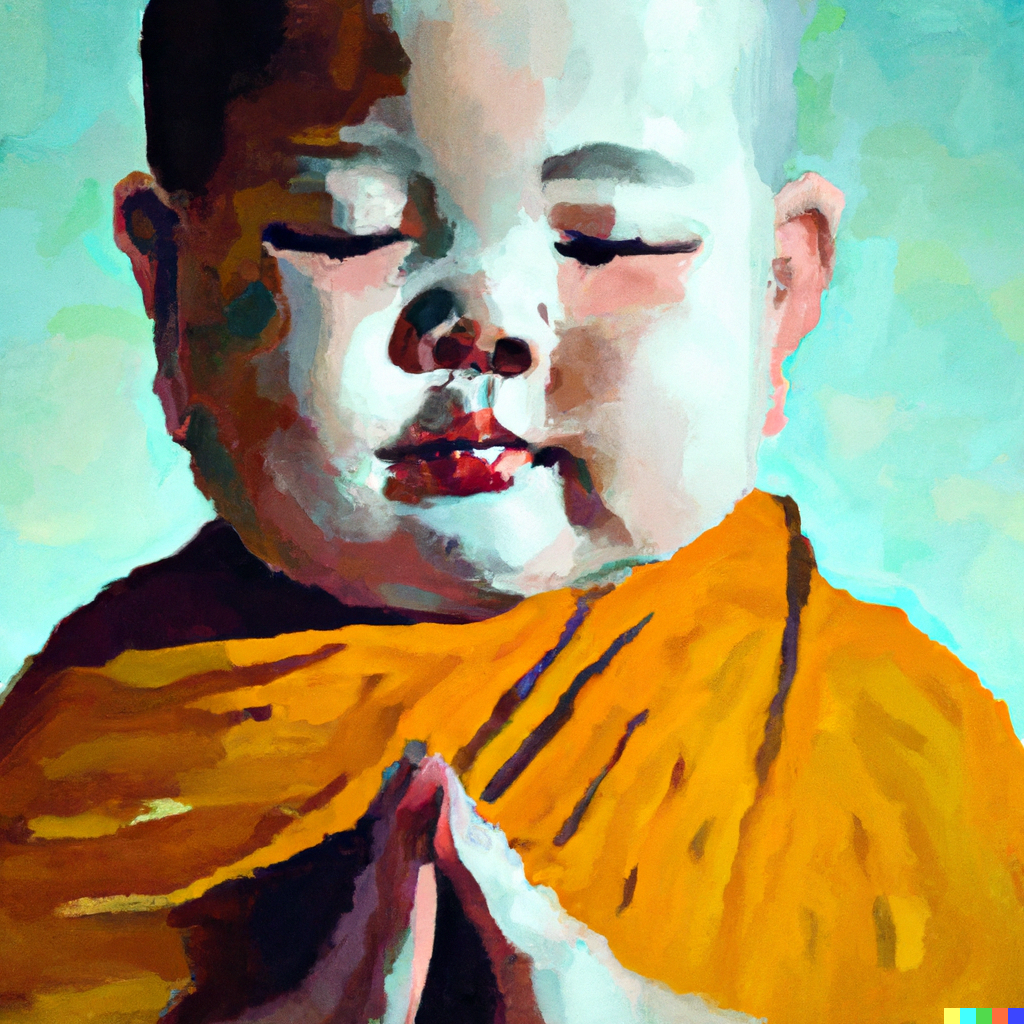
How Buddhism Can Help Us Parent: From Tantrums to Picky Eaters

Raising toddlers can be a rollercoaster ride, and we all know it! From dealing with tantrums to potty training and picky eating, it can feel like we are constantly facing new challenges. But, as parents, we are not alone in this journey and Buddhism can offer valuable guidance to help us overcome these struggles and raise happy, well-adjusted children.
How Does Buddhism Address The Challenges Of Parenting?
Tantrums: We've all been there, the screaming, the crying, the kicking...toddler tantrums can test our patience and make us feel like we are losing our minds. But, Buddhism teaches us the importance of mindfulness, which can help us stay calm and composed during these moments. By acknowledging our child's feelings and giving them space to express themselves, we can help them to regulate their emotions and learn to express themselves in a healthy way.
Potty training: Potty training can be a long and frustrating process for both parents and toddlers. Buddhism teaches the importance of patience, which can be invaluable in this situation. By allowing our child to take their time and not rushing the process, we can help them to feel more comfortable and confident in their abilities. And remember, accidents will happen and that's okay!
Sleep: Sleepless nights and early mornings can be exhausting for parents. Buddhism teaches the importance of mindfulness, which can help us to be more present in the moment and to find ways to relax and unwind before bed. Setting up a consistent bedtime routine and creating a peaceful environment can also be helpful.
Picky eating: Mealtime can be a struggle when dealing with picky eaters. Buddhism teaches the importance of patience and not becoming too attached to the outcome. We can offer a variety of healthy options and encourage our child to try new foods, but ultimately, it's their choice what they want to eat. By not getting too caught up in the outcome, we can reduce the stress of mealtime for both ourselves and our child.
Safety: As parents, our natural instinct is to protect our children, but toddlers are curious by nature and often unaware of the dangers around them. Buddhism teaches the importance of mindfulness and being present in the moment. By being attentive and aware of our surroundings, we can ensure our child's safety while also allowing them to explore and learn.
Discipline: Discipline can be a tricky subject, but Buddhism teaches the importance of compassion and understanding. Instead of punishment, we can teach our child right from wrong through positive reinforcement and setting clear boundaries. By approaching discipline with compassion and understanding, we can help our child to learn and grow in a positive way.
Inability to communicate: Toddlers are still developing their language skills, and this can make it difficult for them to communicate their needs and wants. Buddhism teaches the importance of mindfulness and being present in the moment, which can help us to understand our child's nonverbal cues and respond appropriately.
Keeping them entertained: Toddlers have a lot of energy and need to be kept entertained. Buddhism teaches the importance of mindfulness and being present in the moment. By engaging in activities that are age-appropriate and interactive, we can help our child to learn and grow in a fun and engaging way. One of the best ways is by using tools like Buddha Bear and other books, which are interactive and can help to keep their attention and spark their curiosity while teaching them important lessons.
Separation anxiety: It can be tough for both parents and toddlers when it's time for separation, but Buddhism teaches the importance of mindfulness and being present in the moment. By preparing our child for the separation and staying positive, we can help them to feel more comfortable and confident.
Balancing work and parenting: For working parents, finding balance between work and parenting responsibilities can be a big challenge. Buddhism teaches the importance of mindfulness and being present in the moment
Buddha Bear
Buddha Bear is a great tool to help parents teach these important lessons to their toddlers in a fun and engaging way. It's an interactive children's toy that helps kids learn to be mindful, patient, and respectful of the environment. It's a great way to make the process of teaching these lessons fun and interactive for both parents and children alike.
Conclusion
Buddhism offers many valuable lessons that can be applied to parenting toddlers. By teaching our children to be mindful, patient, and respectful of the environment, we can help them grow and develop into happy and well-adjusted adults. And by using Buddha Bear, we can make the process of teaching these lessons fun and engaging for both parents and children alike. Another interesting aspect of Buddhism in parenting is the concept of non-attachment, which means that we should not become too attached to our children's outcomes, but rather enjoy the journey of raising them and be proud of who they are becoming. By practicing non-attachment, we can reduce our own stress and enjoy the process of parenting more fully.

Finding Purpose in Life: How Buddhism & Ikigai Helped me Overcome Job Loss and Find Fulfillment

We've all been there, feeling lost and purposeless after a major life change. I remember when I lost my job, I felt like my entire world had crumbled beneath me. I didn't know what to do with myself and felt like I had lost my sense of purpose. I felt like a failure, and it was a very difficult time for me. But it was through my struggles that I turned to Buddhism and the Japanese concept of Ikigai.
Buddhism & Ikigai offers unique perspectives on finding purpose in life. Both recognize that true happiness and fulfillment come from living in alignment with our values and finding meaning in our actions. According to Buddhism, when we understand the impermanence and interconnectedness of all things, we can let go of our attachment to the idea of a fixed self and find meaning in the present moment. According to Ikigai, in addition to living in the present, you also need to find something that can support you financially.
According to the teachings of Buddhism, below are 6 steps and realizations that helped me find new purpose.
3 Ways To Find Purpose According To Buddhism
-
Understand the true nature of things: Buddhism teaches that understanding the impermanence and interconnectedness of all things is essential for finding purpose in life. By letting go of our attachment to the idea of a fixed self, we can begin to see the world and our place in it more clearly.
-
Cultivate mindfulness: The practice of mindfulness, which involves paying attention to the present moment without judgment, can help us understand the true nature of reality and find peace in the present moment. This can be achieved through meditation or other mindfulness practices.
-
Develop compassion: Buddhism emphasizes the importance of compassion in finding purpose in life. By developing compassion, we can find meaning in serving others and understand that our actions can have a positive impact on the world around us.
7 Ways To Find Purpose According To Ikigai
-
Discover your passion: Take some time to reflect on what you are passionate about, what activities bring you joy and fulfillment. This will help you to identify the things that you are truly passionate about and that you want to pursue.
-
Identify your mission: Once you know what you're passionate about, think about how you can use that passion to make a difference in the world. What is your mission or purpose in life? How can you use your passion to contribute to society and make a positive impact?
-
Find your profession: Look for ways to turn your passion and mission into a profession. This could involve further education, training or volunteering. Look for opportunities to put your skills and passions to work in a way that is meaningful and fulfilling.
-
Look for what you are good at: Identify your strengths and skills, and think about how you can use them to contribute to the world. This could be through your work, your community or your personal life.
-
Determine what the world needs: Identify the needs of the world and think about how you can use your skills and passions to meet those needs. This could be through volunteering, starting a business or joining a non-profit.
-
Align your passion, mission, profession, skills and the world's needs: Once you have identified your passion, mission, profession, skills and the world's needs, align them to find your Ikigai. It's the intersection of all these elements, your reason to wake up in the morning.
-
Stay motivated: Finding your Ikigai is a continuous process, so it's important to stay motivated. Use tools such as journaling or mentorship to help you stay focused and motivated as you work towards finding your purpose in life.
Everyday Enlightenment: Purpose
For those who are looking for a more structured approach to finding their purpose, I highly recommend the Everyday Enlightenment: Purpose journal. It is a 21-day journal that draws on the principles of Buddhism, Ikigai, & modern psychology to help individuals find their purpose in life. Each day includes a unique breathing exercise, a question of self-reflection, a daily mantra, and an action that the user can take to help them discover their values, align their actions with those values, and find meaning in their life. It's a powerful tool that can help you stay focused and motivated as you work towards understanding the true nature of things, living in alignment with your values and finding your purpose in life.
Conclusion
Buddhism & Ikigai helped me to understand that true happiness and fulfillment come from living in alignment with our values and finding meaning in our actions. The Everyday Enlightenment: Purpose helped me to find new ways to give back and make a difference in the world, which gave me a sense of purpose and fulfillment.
So, if you're feeling lost and purposeless, consider turning to Buddhism and give the Everyday Enlightenment: Purpose journal a try, it might just change your life.
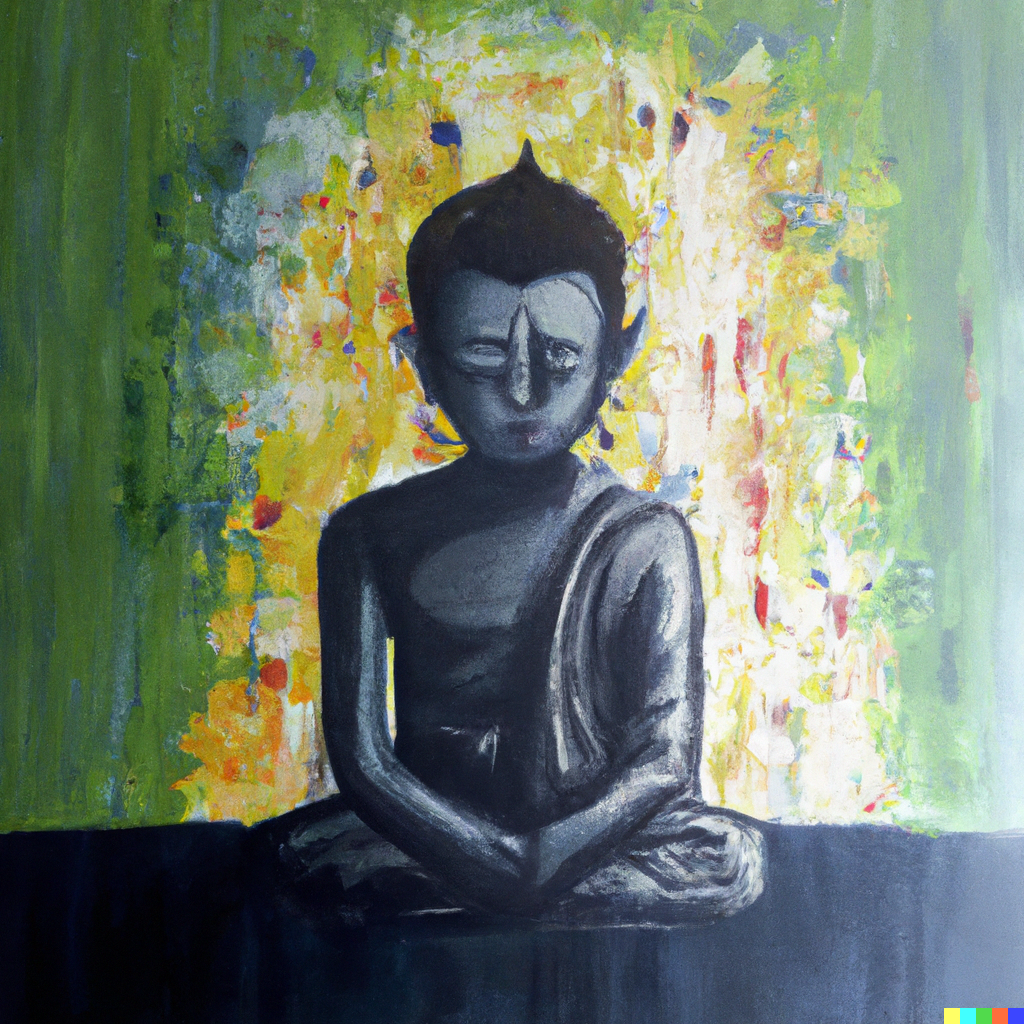
Healing the Heartbreak: How Buddhism Can Help You Overcome Pain and Find Inner Peace

We've all been there, the feeling of heartbreak is all too familiar. It's that feeling of emptiness and pain that seems to linger long after the relationship has ended. I remember when my heart was broken, I felt lost and alone, unable to shake off the feelings of hurt and betrayal.
But as I delved deeper into Buddhism and its teachings, I came to understand that heartbreak is a form of suffering, just like addiction. It arises from attachment and craving for something that we believe will bring us happiness. The Buddha taught that true happiness cannot be found in external things, but rather within ourselves through the cultivation of mindfulness and self-awareness.
Attachment
One of the most important teachings of Buddhism is the idea of non-attachment. When we become attached to a person, we create an unbalanced state in which we cannot see things as they truly are. By cultivating a sense of non-attachment, we can begin to let go of the past and move forward with a sense of peace and freedom.
Compassion
Another important aspect of Buddhism is the practice of compassion. When we're going through heartbreak, it's easy to become consumed by our own pain and to lose sight of the suffering of others. By developing compassion, we can learn to have empathy for our ex-partner and understand that their actions were a result of their own pain and suffering. We can also learn to have compassion for ourselves, and understand that heartbreak is a natural part of the human experience.
Everyday Enlightenment: Heartbreak
For those who are looking for a more structured approach to overcoming heartbreak, I highly recommend the Everyday Enlightenment: Heartbreak journal. It is a 21-day journal that draws on the principles of Buddhism and modern psychology to help individuals overcome heartbreak. Each day includes a unique breathing exercise, a question of self-reflection, a daily mantra, and an action that the user can take to help them move on from the past and build new habits. It's a powerful tool that can help you stay focused and motivated as you work towards lasting change.
Conclusion
Buddhism teaches us that heartbreak is a form of suffering, but it is not something that we have to endure forever. By cultivating mindfulness, non-attachment and compassion, we can begin to understand the impermanent nature of things and let go of the past. The Everyday Enlightenment: Heartbreak journal is a powerful tool that can help you stay focused and motivated as you work towards lasting change and find peace and happiness within yourself. Remember to be kind and compassionate towards yourself, and always trust in the natural process of healing.

Overcoming Addiction: Buddha's Advice

"Addiction arises from a lack of understanding of the true nature of things, and a failure to recognize the interconnectedness of all things." - The Buddha
Addiction comes in many forms and affects everyone from all walks of life. Whether it's an addiction to drugs or alcohol, food, gambling, or even technology, we have all struggled with some form of addiction at some point in our lives.
It's important to understand that addiction is not a moral failing, but a form of suffering that can be overcome through the cultivation of mindfulness and self-awareness. Buddhism provides a unique perspective on addiction, recognizing it as a result of attachment and craving for something that we believe will bring us happiness.
So, whether you're currently struggling with addiction or just looking for ways to improve your overall well-being, this post is for you. Let's dive in and discover how Buddhism can help us overcome addiction and find lasting happiness and peace.
Attachment
One key concept in Buddhism is the idea of attachment. When we become attached to certain things, whether it be a substance, a person, or an activity, we create an unbalanced state in which we cannot see things as they truly are. This attachment leads to a sense of craving, which can manifest as addiction.
Mindfulness
To overcome addiction, Buddhists believe that it is necessary to cultivate a sense of detachment and non-attachment. This can be done through the practice of mindfulness, which involves paying attention to the present moment without judgment. Through mindfulness, we can begin to understand the impermanent nature of things, and learn to let go of our attachment to them.
Compassion
Another important aspect of Buddhism is the idea of compassion. When we are suffering from addiction, it is easy to become consumed by our own pain and to lose sight of the suffering of others. By developing compassion, we can begin to see the interconnectedness of all things, and understand that our own suffering is not unique or isolated. We can also learn to have compassion for ourselves and to see that addiction is not a moral failing, but a result of our own pain and suffering.
The practice of compassion also includes self-compassion, which is the ability to be kind and understanding towards ourselves when we suffer, fail, or feel inadequate.
Everyday Enlightenment: Addiction
Everyday Enlightenment: Addiction is a 21-day self guided journal that draws on the principles of Buddhism as well as modern psychology to help anyone struggling with addiction overcome addiction.
Each day of the journal includes a unique breathing exercise, a question of self-reflection, a daily mantra, and an action that the user can take to help them build new habits and overcome addiction. The purpose of these exercises is to help one help themselves.
The journal is designed to help us set a foundation for change, create a vision for the future, set specific goals, build a plan for achieving those goals, and create momentum towards lasting change.
If you or a loved one has tried everything without success, we highly recommend this journal.
What Would Buddha Say?
If the Buddha were here with us today, what would he say about addiction? Based on the teachings of Buddhism, here's what we think he would say to someone struggling with addiction.
"Your addiction is a form of suffering, but it is not who you are. It is a result of your attachment and craving for something that you believe will bring you happiness. But true happiness cannot be found in external things. It can only be found within yourself, through the cultivation of mindfulness and self-awareness.
I would encourage you to let go of your attachment to the addiction and to focus on the present moment. Observe your thoughts and feelings without judgment, and understand that they are not permanent, but rather fleeting and impermanent. Through mindfulness, you will begin to see the true nature of reality and the interconnectedness of all things.
Also, develop compassion and self-compassion. Have compassion for yourself and others, understand that addiction is not a moral failing but a form of suffering. Cultivate self-compassion, the ability to be kind and understanding towards yourself when you suffer, fail or feel inadequate.
Remember that change is not a one-time event, but a continuous process. Take small steps towards your goal, and be patient with yourself. You are capable of overcoming your addiction and finding lasting happiness and peace. Believe in yourself, your strength and your ability to change."
Conclusion
Buddhism provides a unique perspective on addiction, recognizing it as a form of suffering that can be overcome through the cultivation of mindfulness and self-awareness. The Everyday Enlightenment: Addiction journal is a powerful tool that draws on the principles of Buddhism and modern psychology to help individuals overcome addiction. By using this journal, individuals can learn to let go of attachment, cultivate compassion, and develop self-compassion, all of which are essential for overcoming addiction and finding lasting happiness and peace.
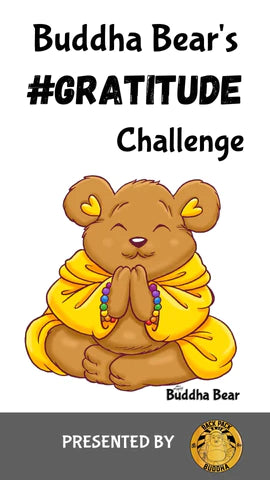
Buddha Bear's #Gratitude Challenge

Enter #GratitudeChallenge here!
We're a karma based business that believes in the power of gratitude and the positive impact it can have in our lives and in turn our communities.
With the help of Buddha Bear, it's our goal to spread the message of gratitude and inspire others to adopt a more positive and grateful mindset.
Everyone wins!
-
Contest Duration: 21 Days (Ends Oct 28th)
-
Prizes for all participants: Gift Certificates from $7 to $70!
-
Grand Prizes for a lucky 8: 1x Blessed Life Balance Mala, 5x Everyday Enlightenment Journal, 2x Buddha Bear's Enlightenment Coloring Book
How to Enter?
-
Register: First click here to register.
-
Choose: to either FaceBook or Instagram to post on.
-
Create a Post: Write what you are most grateful for?
-
Personalize: add a heartfelt photo or video related to your post.
-
Tag us: @Backpack_Buddha and use the hashtags #BuddhaBear and #GratitudeChallenge. Don't forget these tags as this is how we will view your post entries.
-
Multiply Your Chances: The goal of this challenge is to help us cultivate gratitude as a daily practice. Although a single entry suffices to be in the running, we invite contestants to express gratitude every day of the 21 days. The more you enter & share, the greater your chances of winning a grand prize!
*On Oct 28th, all participants will receive their prizes via email. The 8 Grand Prize winners will also receive an email with directions on how to claim their prize.
Why #GratitudeChallenge?
- This is an opportunity for us to take a step back from the hustle and bustle of daily life and focus on the things that you are truly grateful for. This challenge is not only about counting our blessings, but also about taking time to reflect on them and let them sink in.
- By participating in this challenge, you'll be training your brain to look for the good in every situation, which can improve your overall mood, reduce stress, and increase your sense of happiness and contentment. When you make gratitude a habit, you'll start to notice that it becomes easier to find things to be thankful for, even on the toughest days.
- Gratitude also has a positive impact on your self-esteem and confidence. When you focus on what you're grateful for, you'll find that you're less likely to compare yourself to others or dwell on your own shortcomings. Instead, you'll be more likely to appreciate your own strengths and the things that make you unique.
So, let's get started! Take a deep breath, grab your mala if you have one, and let's begin counting our blessings.
Whether you're doing the challenge for a day or 21 days, you'll be surprised at the positive impact it will have on your life. Get ready to feel happier, more confident, and more fulfilled.
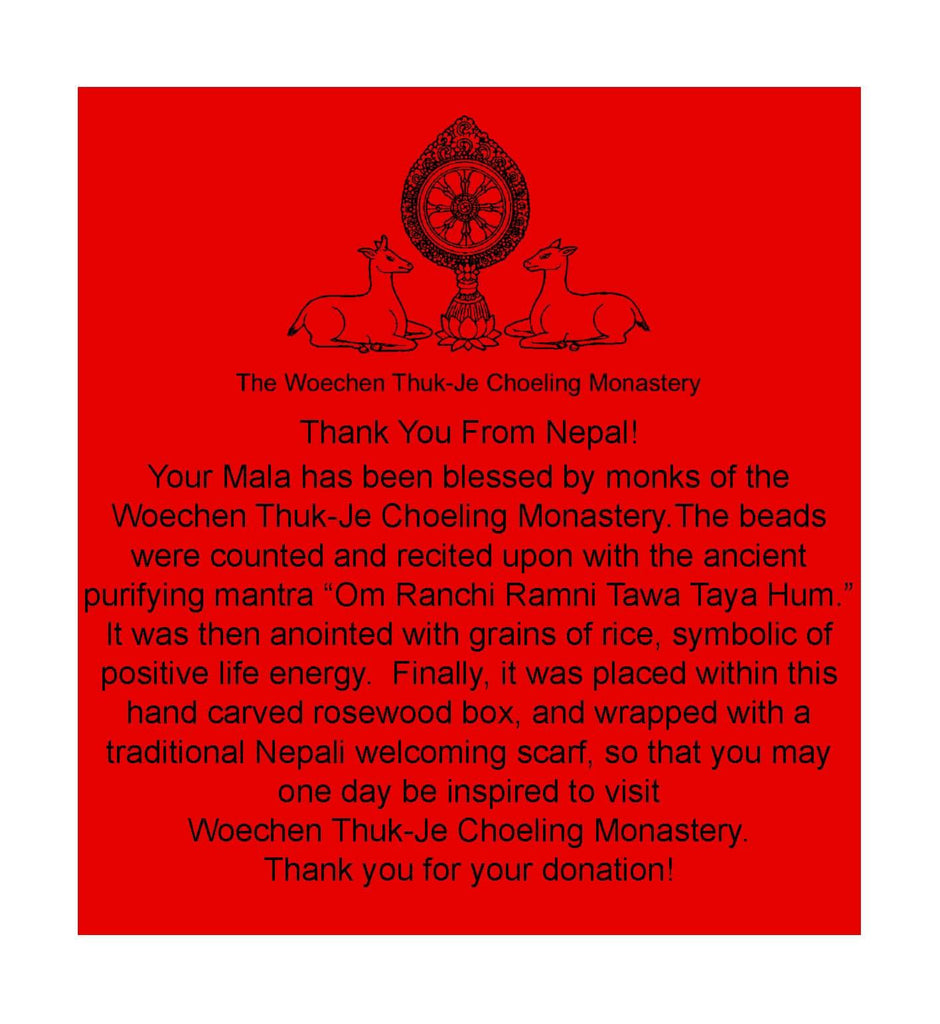
The Power of a Blessed Mala: Understanding the Significance of a Mala Blessed at the Swayambhu Temple in Kathmandu
Mala beads, often used in meditation and prayer, have become increasingly popular in recent years. But what makes a mala truly special? Some argue that a mala is not truly blessed until it has been prayed over at one of the holiest temples in the world, such as the Swayambhu temple in Kathmandu.
A mala is a string of beads, traditionally 108 beads, that are used for counting mantras, prayers, and intentions. They are often made of natural materials such as sandalwood, seeds, or stones, and can be worn as a necklace or bracelet.
But what sets a blessed mala apart from others?
The act of blessing a mala is said to infuse the beads with positive energy and intention. When a mala is blessed at a holy temple or by a spiritual leader, it is believed to carry the energy and blessings of that place or person. This can make the mala a powerful tool for personal growth and spiritual development.
View our Blessed Mala Collection
One of the most well-known places to bless a mala is the Swayambhu temple in Kathmandu, Nepal. Each year, tens of thousands of people make the pilgrimage to this temple to walk up the 365 steps and spin each prayer wheel as they make 108 revolutions. According to the Seventh Dalai Lama, this temple is the source of all the happiness in the world. It is a powerful place of worship and devotion.
Woechen Thuk-Je Choeling Monastery
Just behind the Swayambhu temple is the Woechen Thuk-Je Choeling Monastery, whose founder, His Eminence Ven. Drubthob Rinpoche, is dedicated to the “restoration of a harmonious human society, and for the well-being of every sentient being in this world.” It is by the monks of this monastery that Backpack Buddha blesses its Malas.
When a mala is blessed by the monks of this monastery, it is done with the intention of promoting a harmonious human society and the well-being of every sentient being in the world. These Malas are not just a fashion accessory, but a tool for personal growth and spiritual development.
Blessed malas can also serve as a reminder of a special place or event in your life. Whether it's a mala blessed at a spiritual retreat or one that you picked up on a pilgrimage, these malas can help to hold on to the memories and emotions associated with that experience.

Another benefit of a blessed mala is that it can serve as a reminder to stay focused on your intentions and goals. When you wear your mala, you can use it to remind yourself to stay present, be mindful, and stay focused on what's important to you.
It is important to note that these Malas are often a limited edition and created per customer. So, you can be sure that you are getting a truly unique and blessed mala.
In conclusion, a blessed mala may not be for everyone, but for those who believe in the power of prayer and the intention behind the mala, it can be a valuable tool for personal growth and spiritual development. It can serve as a reminder of a special place, a reminder to stay focused on your intentions, and can also be used as a way to support a noble cause.

The Journey to Enlightenment: How the World's Great Religions Teach the Path to Inner Peace and Spiritual Awakening

Enlightenment is a concept that has been explored and sought after by many different cultures and religious traditions throughout history. From Buddhism and Hinduism, to Christianity and Islam, the world's great religions all offer a path towards a deeper understanding of oneself and the world around us. They teach us to look beyond our everyday concerns and find inner peace, wisdom and inner happiness.
If you are interested in finding a way to explore the path of enlightenment, "Everyday Enlightenment: Beginnings" journal can be a great tool to help you take your first steps on your path. With daily prompts, exercises, and reflection questions, the journal guides you through a 21-day experience that encourages one to look at enlightenment through different perspectives, making it a great way to start a journey towards inner wisdom. It's a way to take the teachings of the world's great religions and apply them to one's own life, in a practical and personal way.
How Do The World's Great Religions Teach the Path to Enlightenment?
*It is worth noting that the idea of enlightenment, its meaning and its path of attainment may vary within the different sects or denominations within the same religion, it's not a one-size-fits-all concept.
In Buddhism
enlightenment is known as "Nirvana" and is described as the state of being free from suffering and the cycle of rebirth. The Buddhist path to enlightenment involves following the Eightfold Path, which includes practices such as right understanding, right intention, right speech, right action, right livelihood, right effort, right mindfulness, and right concentration. By following the Eightfold Path, Buddhists aim to develop wisdom, compassion, and inner peace, and ultimately to transcend the ego and realize the interconnectedness of all things.
In Hinduism
enlightenment is known as "Moksha" and is described as the state of liberation from the cycle of reincarnation and union with the ultimate reality. The Hindu path to enlightenment involves following the Four Purusharthas which are: Dharma (duty), Artha (material wealth), Kama (pleasures), and Moksha (spiritual liberation). The path also include yoga, meditation, devotion, study of scripture and service to others. It's understood that the ultimate goal of these practices is to transcend the ego and realize one's true nature as part of the ultimate reality or Brahman.
In Jainism
the path to enlightenment is known as "Nirvana" or "Kaivalya" and is described as the state of being free from the cycle of reincarnation. Jainism's path is based on the Three Jewels: Right Faith, Right Knowledge and Right Conduct. It emphasizes on non-violence, non-attachment and self-control as essential steps towards spiritual advancement. The ultimate goal is to attain spiritual liberation by purifying the soul and ultimately attaining a state of perfect knowledge, vision, conduct and power.
In Sikhism
enlightenment is known as "Mukti" and is described as the state of union with the ultimate reality. Sikhs believe that the ultimate goal of human life is to merge with the ultimate reality, or God. This is achieved by following the teachings of the Gurus, performing selfless service, and engaging in the practice of meditation and prayer. The focus is on living a virtuous life, based on the principles of love, devotion and self-surrender, and ultimately to transcend the ego and realize one's unity with God.
In Christianity
enlightenment is referred to as "Salvation" or "Union with God" and is described as the state of being saved from sin and eternal death, and gaining eternal life in heaven. The Christian path to enlightenment involves a personal relationship with God through faith in Jesus Christ and repentance for past sins. Christians believe that by following the teachings of Jesus, living a virtuous life, and through the sacraments of the church, they can achieve salvation and eternal life with God.
In Islam
enlightenment is referred to as "Tawheed" or "Oneness" and is described as the state of knowing and experiencing the unity of God. The Islamic path to enlightenment involves the submission to the will of God and adherence to the Five Pillars of Islam: the declaration of faith, prayer, fasting, giving to charity, and pilgrimage to Mecca. Muslims believe that by following the teachings of the Quran and the example of the Prophet Muhammad, they can achieve a deep understanding of the unity of God and ultimately reach a state of spiritual enlightenment.
In Judaism
enlightenment is referred to as "Devekut" and is described as the state of spiritual attachment to God. The Jewish path to enlightenment involves the study of the Torah, performing mitzvot, and engaging in prayer and meditation. Through these practices, Jews believe they can achieve a deeper understanding of God, and ultimately reach a state of spiritual enlightenment and connection to God.
Conclusion
In summary, each of the world's great religions emphasizes different practices and teachings, but they all strive to help followers reach enlightenment, which is often described as a state of wisdom, inner peace, and spiritual connection to the ultimate reality. The path to enlightenment may involve studying spiritual teachings, engaging in meditative and contemplative practices, living an ethical and compassionate life, and developing a personal relationship with the divine. And even though each religion emphasizes different paths and methods, they all ultimately aim to transcend the ego and experience a deeper understanding and connection to the ultimate reality.
Final Remarks
Additionally, it's important to remember that enlightenment is not a destination, but rather a lifelong journey of personal growth and self-discovery. It's not something that can be attained overnight, but rather something that takes time and effort to achieve. Each person's journey to enlightenment is unique and personal, and it's important for individuals to find the path and practices that resonate with them the most.
It's also important to mention that some believe that enlightenment is not something that can be taught, it can only be realized through self-discovery and self-realization. And that any guide, teaching or religious doctrine can only point the way but can't guarantee enlightenment.
In conclusion, achieving enlightenment is a central goal in many of the world's great religions and each tradition has its own unique path and teachings for reaching this state. The path to enlightenment may involve studying spiritual teachings, living an ethical and compassionate life, engaging in meditative and contemplative practices, and developing a personal relationship with the divine. However, it's important to remember that the journey to enlightenment is a personal one and it requires time, effort and a willingness to let go of the ego and to transcend it.

Breaking the Cycle of Self-Sabotage: A Guide to Unconditional Love

On my 35th birthday, I found myself alone in New York, feeling incredibly lonely. I had just ended my latest relationship, and it felt like I had been stuck in a cycle of failed relationships. I couldn't help but wonder if I would ever find someone to share my life with. I felt like I was living in a never-ending episode of "Sex and the City."
"What's the point?" I yelled into my pillow. "When am I going to find happiness?" I screamed!
I was just so sick of it all. I spent the next few weeks wallowing in my own misery, watching Netflix under a pile of blankets and eating chips and whipped cream. It was pretty pathetic. But then, one day, a friend came over to try and cheer me up.
"If only you had come over two weeks ago for my birthday! What kind of friend are you anyways?" I thought begrudgingly to myself. After a bit of chit chat, she pulled out a beaded necklace that resembled a rosary.
"What's that? It's pretty," I said, reluctantly.
"This is how you're going to get out of this funk," she exclaimed with more enthusiasm than I could handle at that moment.
"Looks like a perfect thing to hang myself with," I chuckled jokingly.
"Okay, enough of that talk. Here's what you're going to do. Roll each bead in your fingers and think of something you're grateful for. Then keep doing that until you've gone through all the beads." She said, in the tone of a middle school teacher.
"There's a lot of beads here," I gawked.
"108 actually," she replied.
I had never been against mindfulness & meditation, but I guess I just never really had had the opportunity to try it out before.
"Fine! I'll do it." I said as I swiftly grabbed the Mala from her hand.
"I'm grateful for my apartment. It's small but it's my space. I'm grateful for my job. I don't always like it, but it can be fun sometimes. I'm grateful for the sun lol."
After the first 10 beads, I struggled to come up with things I was grateful for. But before I knew it, 30 minutes had past and I had found 108 things to be grateful for. In all honestly, I really felt...well...better. I was immediately brought into the present moment by doing this simple exercise.
I know it sounds a bit corny, but this truly was the beginning of my journey.
Over the next few months meditating with my new Mala,
I realized 4 things that were keeping me from finding true love and overall contentment in my life.

1. Fear of rejection:
This was a big one for me. Fear of being rejected or not being good enough prevented me from putting myself out there and opening myself up to new possibilities. It led to self-doubt and a lack of self-confidence, which made it impossible to find love. To overcome this pattern, I focused on building self-confidence and self-love. Through mindfulness exercises with my Mala, I learned to challenge negative thoughts and remind myself of my strengths and positive qualities. Side note: it's important to remember that rejection is a natural part of the process, and it's defintiely not a reflection of your worth as a person.
2. Seeking validation from others:
I realized that I too often sought out validation from others to confirm that I was worthy of love, which led to a cycle of relying on external validation to feel good about myself, and in turn, making it harder for me to find and keep a healthy, loving relationship. To overcome this pattern, I focused my meditations on building self-worth and self-acceptance. Feel free to use the same affirmation I recited on my beads, "my worth as a person is not defined by the validation of others."
3. Holding on to unrealistic expectations:
I used to have unrealistic expectations of what I wanted in a partner, and this lead to disappointment and dissatisfaction more times than I could count. Now I understand that relationships take work and compromise, and that no one is perfect. Through my meditations, I now have a better understanding of what I want and need in a partner and it helps me to be more realistic in my search.
4. Past trauma:
I've been through some traumatic experiences in the past that I realized were causing difficulties for me in building healthy relationships and trust. I traced much of it back to my father, who was an alcoholic. Although it took some time confronting these feelings, it was absolutely worth it. Ultimately, I realized that all of my patterns of insecurity and self-sabotage stemmed primarily from the trauma I experienced as a child.

Did I Find Love?
With the help of the same blessed Buddhist Mala my friend gave me, I had started some healthy new habits. I was able to understand and thereby break the cycle of negative patterns and habits that held me back. I no longer attract the same type of god-awful partners and instead, I recently found someone who truly complements me and accepts me for who I am. I'll save that story for my next post though ;) Every day this Mala serves as a beautiful reminder to practice unconditional self-love and acceptance. It also helps me remember how how far I have come.
Final Thoughts
If you're ready to change your negative habits and open yourself up to new possibilities in love and life in general, I highly recommend incorporating a Buddhist Mala to help start a meditation and mindfulness practice. It can be a powerful tool to help you become more self-aware and to help you break free from negative cycles. While you don't necessarily need a Buddhist Mala, I do recommend it if only for the fact that it's a stylish reminder to stay positive and in the present. Plus, there's gotta be a reason why humans have been reciting prayers and counting on mala beads for thousands of year. In the end, remember that finding love starts with loving and accepting yourself, so make sure to prioritize self-care and self-acceptance as a foundational pillar.
*If you're interested in the Mala my friend gave me, you can find it here, "Unconditional Love Mala."

Incredible Benefits Of Gratitude Journaling: How To Get Started Today
 There are many benefits of gratitude journaling. Writing down everything that you are thankful for on a regular basis helps to mould your perceptions to a healthier, and better standard. This exercise also builds the habit of seeing the good things in life which are abundant, but often unnoticed.
There are many benefits of gratitude journaling. Writing down everything that you are thankful for on a regular basis helps to mould your perceptions to a healthier, and better standard. This exercise also builds the habit of seeing the good things in life which are abundant, but often unnoticed.
Gratitude is so important as it's directly associated with your overall sense of happiness and well-being. The more gratitude that you feel, the more you will experience desirable emotions and positive outlooks about life and oneself.
Gratitude can be difficult to experience for some people, especially if they are not accustomed to it. It’s easy to get stuck in a victim mentality where life itself seems to be against you, because you find yourself cherry-picking all of the tiny negatives in life.
This is where the practice of writing down everything that you are thankful for helps you realize how much you can be thankful for, all the time.
By gratitude journaling, you’re going to flip this perspective and train your mind to cherry-pick the small everyday positives instead. This can have a great effect on you as it promotes positive life enhancing qualities, and does wonders for your overall sense of happiness and satisfaction in life.
There is always something that you can be grateful for. From the sun warming your skin and the fresh air circulating through your lungs, to the painful experiences that we all encounter which give us powerful life lessons.
Gratitude journaling helps you to reinforce a more positive outlook, which seeps into all aspects of your life. By strengthening this mental muscle, you will appreciate the everyday occurrences more, and see the light in all situations; because there is always something good to come out of even the hardest experience.
The more aware you become of the positive occurrences happening all around you at every moment, the better you will feel about your life situation. You will realize that things aren't so bad, and that there's always something to be thankful for.
This is why you should start gratitude journaling today, for a more positive tomorrow.

What are some benefits of gratitude journaling?
-
Gratitude journaling makes you more positive by keeping you focused on the good things in life.
-
It changes your perceptions and mentalities to better standards, as gratitude journaling trains your mind to realize how much you have to be grateful for.
-
Keeping a journal of what you’re thankful for helps you to become a genuinely more optimistic person. By doing this, you will start to see that even in the worst times, there is something good to come from them, or that any situation could be worse than it is.
-
Gratitude journaling helps to reduce stress.
-
It helps you get rid of those stubborn toxic emotions, by replacing them with positive emotions such as joy and acceptance.
-
It improves your self-esteem and your self-image.
-
Ultimately, it feels good to be grateful!
How to kick-start the habit of gratitude journaling
You should have a diary or notebook specifically for gratitude. If you don't have one, buy a journal and put it aside for this exercise. Here you can grab a unique Buddha vision journal, or an authentic Buddhist Lokta Paper Journal to get started!
Keep it in a convenient and easily accessible location with a pen handy. This practice only takes roughly five to ten minutes a day, and has potentially huge benefits on your state of well-being.
Recall and write down the positive events of every day
Aim to write a minimum of five entries a day, and try to expand on them. Instead of writing a word or two, write a couple of sentences explaining why you feel grateful for these things.
Don't fill pages with empty words, but make them as accurate as possible. Feel the sensations of gratitude as you write the entries down. Be authentic with what you feel, and feel the desirable emotions as you think about each entry.
Write down everything that you can feel happy about. Jot down what you believe you did well in, what you got lucky with, and that didn't go wrong.
Take note of acts of kindness and things that people did for you. Write them down and reflect on the experiences, which will help strengthen the sensations of gratitude.
It's better to write down daily occurrences rather than things that will always be there. It's important to be grateful for everything you have including freshwater, a warm bed, and food, but try to avoid writing these down as daily entries.
Your entries should be diverse and accurate. Make them unique, so the journal entries won't repeat themselves.
Build the habit of noticing the small victories of every day, and it will become a habitual practice. The more you begin to notice the positive occurrences of every day, the more positive you will feel.

How can I make the practice of gratitude journaling more effective?
- Make each point authentic. If you’re just writing things down for the sake of doing it, then you won’t get too much out of it. That’s why it’s important to be authentic, and to write down entries which you actually feel grateful for.
- Don’t be vague. You need to be precise about writing what you feel and why you feel it. If you write a few words like “it was a good day”, you are not pinpointing the emotion that you’re looking for. Why was it a good day? what exactly happened to make it a good day? When did you feel the sensation of gratitude? Make sure that you add the details and write a little more to really dig into the emotion of gratitude.
- Feel the emotions as you write them. The whole practice and point of gratitude journaling is to recall the emotions as you write them down. You’re trying to make a regular practice of feeling gratitude and training your mind to think in a different way, therefore, you need to be connected to what you write down. Think about what happened, and be present with the joyful sensation. If you’re grateful because something bad didn’t happen, sit with the feeling of relief as you write it down. If something good happened, or you got lucky with something, really think about it as you write it down. This will make the practice much more effective.
- Be consistent. As you’re trying to form a habit, you need to be consistent, and do it every day. Try spending at least 5 minutes a day writing a few entries until it becomes a habit. If you only write things down here and there without being consistent, it’s going to be much harder to build the habit.
- Constantly think about what makes you feel good. Be aware and keep your eyes open for moments to be grateful. You can use emotions like relief to extract gratitude. Likewise, use contrast to be grateful. If you were sick, appreciate how good it feels when you are good and healthy. If you had a bad day at work, use it to feel great when things go well. There is an endless amount of opportunities at any given moment to feel grateful. Keep a look out for them!
What are some gratitude journal examples?
Look for every opportunity to be grateful that you can, and learn to find gratitude out of any, and every situation. The more you train your mind to see the good in everything, the more you will feel it all throughout your day. Here are some examples of what you could write down.
- I'm thankful that I didn't run into much traffic today. I often get stuck in traffic on my way to work, and this makes me frustrated.
- Thank you to the person who held the door open for me today. It made me feel welcome.
- I am grateful that I felt sad and cried when reminiscing over my deceased friend. It allowed me to vent out what I was bottling up, and I felt much lighter afterwards.
- Thanks for the wonderful meal I shared with my partner today. It was absolutely delicious, and she/he cooked everything without accepting my help.
- I’m glad that I went through this painful experience today. It made me realise my own strength and capabilities, and now I have a great story to tell!
- I am grateful for a nice and easy work shift with no hassles or drama. It made my day go much smoother which is a good feeling.
- I’m grateful that I’m feeling much better today. The last few days were rough, but now I appreciate what it feels like to be healthy and able to do things.
- I’m grateful for the amazing sleep I had last night. Usually my sleep is very disrupted and I don’t feel refreshed when I wake up, but last night I slept like a log. A good night’s sleep completely changed my day!
- Thank you to my friends who invited me out. Even though I didn't go, it made me feel appreciated and cared for.
- I’m grateful that the train arrived right on time. I was already running late and stressed that I might not have made it to work on time if the train was delayed.
- Thanks for the awesome weather today! I walked home and it made such a pleasant time. I was worried that it might have rained.
- I am grateful that my t-shirt didn't get stained. I was worried about that when eating that messy meal.
- It was so amazing to meet that person at the café today. We made a great connection and had an interesting chat. That doesn’t happen often.
- I’m so happy that I didn’t fall down and hurt myself. I had a bad slip today but caught myself. That could have ended badly.
Now it’s your turn.
What are you grateful for?
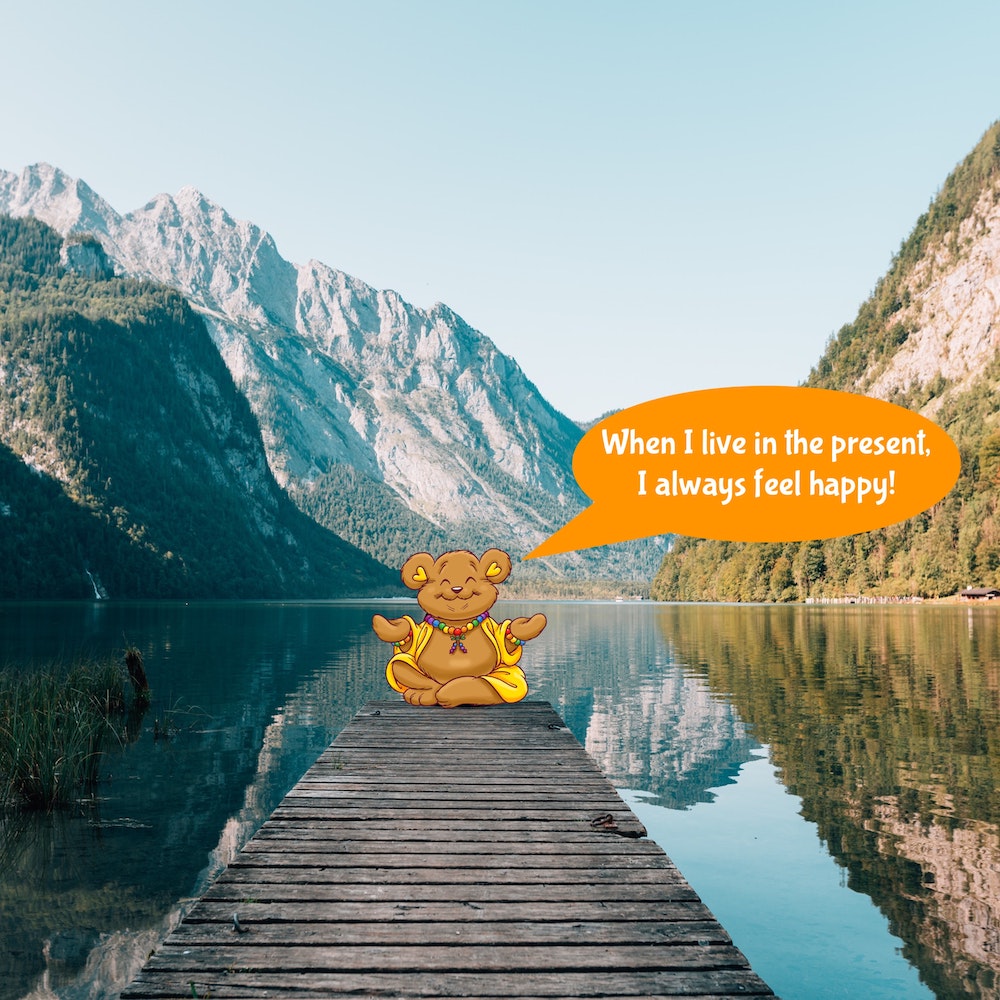
Mindfulness & Its Remarkable Impact On Child Development

Mindfulness has long been revered by yogis, gurus and healers of all kinds as a highly transformative practice. In recent years, mindfulness activities like meditation have even gained traction in school settings as viable alternatives to traditional disciplinary methods.
However, until recently, little was known about the underlying mechanisms that drive the ‘magic’ of mindfulness.
Neuroscientists and psychologists are finding that mindfulness not only changes our mental outlook on life, but literally changes the landscape of our brains.
Researchers have found that integrating mindfulness based interventions (MBIs) in school contexts reduces attention control problems and improves students’ cognitive performance.
Specifically, mindfulness activities have shown to increase grey matter in parts of the brain that support learning and memory.
Mindfulness also reduces circulating cortisol levels, decreasing the body’s level of stress and stress-related inflammation.
In children specifically, mindfulness has been proven to reduce activity in the amygdala, the brain's emotional regulation center, essentially recalibrating the brain’s unconscious response to fear.
This means that if introduced early, mindfulness can fortify children’s resiliency and improve their ability to cope with high stress situations, both in school and life.
Mindfulness has also notably been proven to change students' outward behavior. One study of four schools saw reduced incidents of bullying and disruptive behavior in classes that adapted mindfulness as part of their curriculum.
According to scientists, one underlying mechanism for this change in social behavior is that mindfulness increases the volume of the temporoparietal junction, the brain area known to support empathy and compassion.
This science proves something perhaps we’ve long suspected; that when we nurture young minds, we don’t just change how children react, but importantly, the kind of people they become.
So, to summarize:
- Mindfulness positively impacts children’s focus and attention by decreasing mind wandering
- Mindfulness can improves cognitive performance and promotes growth in areas associated with learning and memory
- Reduces both the presence of stress and the amygdala’s response to stress, increasing resilience in scary situations
- Mindfulness Interventions positively impact children’s behavior, reducing disciplinary issues such as bullying
- Mindfulness supports growth in the areas of the brain responsible for empathy and compassion.
As more and more evidence is becoming available, it is clear that mindfulness is an invaluable tool that parents and educators can use to promote healthy cognitive and emotional development in children.
To learn more about mindfulness, and find fun and easy mindfulness practices you can do with your child at home, check out: 21 Mindfulness Exercises For Your Kids and the companion workbook: Buddha Bear’s Enlightenment Coloring Book.

21 Exercises For Your Kids In Mindfulness, Confidence, & Gratitude
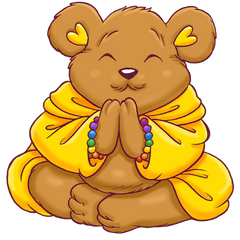 Mindfulness is the process of simply being in the present moment. It is often seen as the first step to finding inner peace.
Mindfulness is the process of simply being in the present moment. It is often seen as the first step to finding inner peace.
Mindfulness is a particularly important skill for children as they are just beginning to learn how to relate to themselves, others, and the world around them.
The following exercises are inspired by Buddha Bear's Enlightenment Coloring Book. They are designed to help you to connect with your child’s inner world, and build greater emotional & spiritual awareness, self confidence and gratitude together!
We've broken this guide into 3 parts. In part 1 you'll find 7 activities you can do with your kids to increase spiritual awareness. Part 2 deals with fear and confidence. Finally, part 3 is all about gratitude and how simple exercises of gratitude can translate into greater inner contentment.
May this guide serve as medium towards greater contentment & love for you and your kids.
*If there's an exercise you feel we should add to this guide, please let us know in the comments below!
Part 1: Emotional & Spiritual Awareness For Kids

1) I Am Present Meditation
Have your child sit down with eyes closed, and prompt them to notice the feel of the room; Is it hot or cold? Can you feel a breeze? What kinds of sounds can you hear? Is it noisy or quiet? Is there anything you can smell?
After a minute or two, ask them to shift their focus to how they are breathing. Is your breath short or is it longer? Can you feel your chest or belly move as you breathe in and out?
Now, ask them to try to notice both the sensations happening outside and inside at the same time. Have them hold this awareness for several minutes.
2) Become A Backyard Detective!
Find an outdoor space to explore such as the backyard. Ask your child to walk slowly, and try to notice things about this space they never knew before using ALL the senses. Like a detective, they should literally leave no leaf unturned. Ask your child to keep track in a notebook or in their head of three things they saw, smelled, felt and heard that surprised them. Have them share their surprising findings at the end.
3) Nature Yoga Inventor
For this activity, your child will create their own yoga poses based on things they find in nature. (i.e. “bush pose”, “spider pose”, “frog pose” etc). Have them explore outside for 15 minutes and come up with 3-5 yoga postures based on things they see. In the end, ask them to teach you their postures so you can do them all together. Over time, they can string the poses together to make their own custom yoga routine. The possibilities are endless!
4) When Your Kids Feel Nervous: Breath Counting
Have your child sit crisscross with their palms facing down. As they inhale, have them count to 5, lifting a finger up as they do (i.e. 1. lift both thumbs up, 2. index fingers, and so on). When they reach five, have them countdown with their exhale, placing the fingers down in reverse (5. Pinkies down, 4. Ring finger, and so on). Have them do this three times with their eyes closed while you count and then once on their own.
5) When Your Kids Feel Angry: The Lion's breath.
Lion’s breath is used in yoga to release heat and stimulate circulation in the body.
Have your child take a deep breath in and hold their breath while they scrunch up their face as tight as they can. You can tell them to imagine that they just ate the sourest lemon or candy. Have them hold this for a few moments and then tell them to stick out their tongue, open their eyes wide and exhale out their mouth with one BIG sigh (or roar!). HAHHHHHHHH!!
6) When Your Kids Feel Sad: 4 Part Heart & Belly Breath
This can be done seated or lying down. Have your child spend a few moments just noticing their normal breath. Ask them to notice if they are breathing more with their belly or their chest. Then ask them to place their right hand over their heart and left hand on their belly, just underneath the belly button. Have them take a normal exhale and begin:
- Inhale into the belly and feel the belly pressed against your left hand.
- Take that same inhale up into the chest, feel the chest rise up into your right hand.
- Exhale slowly from the chest, feel the chest fall away from the right hand.
- Exhale slowly from the belly, feel the belly fall away from the left hand.
Guide them through this 3-5 times with your words, and then have them do it 1 more time on their own.
7) Just for fun: Rainbow breathing
From seated, have your child bring both arms over to one side, with hands touching the floor. As they inhale, have them reach their arms up overhead in a sweeping motion, and exhale the hands over onto the other side, creating an arch. If it helps, ask them to visualize painting a rainbow with their hands in the sky above them.
Part 2: Confidence Building Exercises For Your Kids!
1) The “I DID IT!” Dance
The dance is simple and can be done standing, seated or lying down (this is my favorite!). Have your kid spread their arms and legs wide, like a starfish. Then have your child bend their right elbow and right knee towards one another as they yell “I DID IT!”. Have them straighten out and repeat on the left side. Do this three times on each side. This can be used as a cheer any time your child tries something new!
2) Build-Your-Own Affirmations
Together with your child, come up with some affirmations that they would like to use. Some examples include: “I am safe”. “I love myself”, and “I can be all that I want to be”. Remember that affirmations are most powerful when they are in the present tense (“I am” vs “I will”) and centered on the individual (“I am loved” vs “people love me”).
Have your child say each one out-loud, as many times over as they can for a full minute. Repeat for each affirmation. This can be made part of a morning or bedtime ritual as well as used in times of need.
3) The Positivity Bank
With your child, create a list of positive things. You can use affirmations, compliments, jokes, song lyrics, things you are grateful for, or any other tidbits that inspire happiness. Write each one down on a small slip of paper then fold each paper and place it into a spare jar or box. Have your child decorate their container with positivity; positive colors, positive pictures, positive ribbons. Once complete, they can pull a positivity ‘fortune” from their Positivity Bank any time they like! They can also make ‘deposits’ of positivity for future ‘withdrawals’!
4) The Friendship Smile
Have your child sit down in a comfortable position and close their eyes. Ask your child to think of someone they love, someone who easily brings them joy and happiness. Ask them to imagine this person smiling at them. Tell them to imagine this person’s smile growing bigger and bigger until it is the biggest, widest smile ever. They might begin to feel a smile appear on their own face. Tell them to let their own smile get bigger and bigger until they too are smiling the biggest, widest smile that they can.
Have them hold this smile for several moments. When they’re ready to leave, let them know that they can always close their eyes and go back to ‘visit’ the friendship smile anytime they want to.
5) Superhero Power Pose!
This is a great exercise for building lasting confidence and emotional endurance for your kids!
Have your child lay down on their belly with their arms outstretched in front of them and fingers curled into fists, superhero style. Tell them that they are going on a very important mission and when you count down to one, they need to lift their arms and their legs so they can soar! Countdown 5-4-3-2-1! Have them hold the Superhero Pose for five seconds, then release. Repeat for 10 seconds and release. Last round is just five more seconds. It helps to cheer them on: “You can do it!”, “You are strong!”, “You’re a Superhero!”.
6) The Magic Mirror
Have your child take a piece of paper and trace or draw an oval shape on it. Have them close their eyes and think about three or more things that they feel happy, strong or proud doing. They might draw from sports activities, hobbies, personal strengths, friendships or other experiences. Have them write words or phrases for each around the frame of the mirror. On the inside of the mirror, have your child draw symbols or pictures of themselves doing the things that make them feel happy, strong and proud.
Explain to them that this is a magical mirror that shows their true inner power and that they can consult the mirror anytime they need a reminder of how strong they are.
7) I AM... Bookmark
Take a piece of regular 8.5 x 11 paper and cut it into four long strips, lengthwise. These strips will become your bookmarks. On each strip, have your child write their name down vertically, one letter at a time. For each letter of their name, have them think of an adjective that starts with that same letter and write that adjective next to or below each letter.
On the back, have them write the phrase “I am _______.” for each letter of their name, filling in the blanks with the adjectives that they chose. One the other three slips of paper, you can have them repeat the activity with their middle or last name(s) or have them make one for a friend.
8) Loving Kindness Meditation
This Loving Kindness Meditation is based on the Metta Prayer in Buddhism. The idea is that we can draw from the loving kindness that we so easily feel for those closest to us and learn to amplify that feeling towards others and ourselves. This is a great exercise for practicing self-love and empathy.
From a seated position, ask your child to think of someone they love, someone who easily brings them joy and happiness. Next, have your child repeat the meditation as you say each part out loud. Tell them to imagine saying the words to this person.
May you be safe
May you be happy
May you be healthy and strong
May you live with peace
Repeat for
- A neutral person (someone they don’t know as well)
- Themselves (replace “you” with “I” when reading)
- Someone that they have challenging/negative feelings towards
- Every being in the world
Part 3: Introducing Our Kids To Gratitude
1) Rose Thorn Bud Gardener
This practice is best implemented at the end of the day or after school. First, have your child reflect on their day by asking them to identify the rose, thorn, bud and gardener of their day.
- The rose is the best thing about their day
- The thorn is the worst part of their day
- The bud is something they are looking forward to
- The gardener is someone who helped them during the day
You can go through these questions as part of a nightly daily check-in with your child or encourage them to reflect on their own in a journal or art project. You can also encourage them to write a Warm Fuzzy thank you note to their ‘gardener’ (see below).
2) Warm Fuzzies
Each day, have your child reflect on one (or more) people they appreciate for helping them, for making them laugh, for being kind to them or for just for being themselves.
Have them write a card using the sentence, “I appreciate [ NAME ] for …. “ and sign at the bottom with their name. They can choose to deliver the Warm Fuzzy to the person or keep it as a reminder for themselves.
3) The Gratitude Tree
First, choose a place to put your Gratitude Tree, ideally a place you will pass by regularly. Have your child help you make the tree trunk and branches using cardboard, paper, paint, etc. Next, cut out pieces of paper roughly the size and shape of small leaves and stack them in an empty box near your tree. Each time that your child, or anyone in the family thinks of something they are grateful for, they can write or draw it onto a leaf and attach it to the Gratitude Tree.
At the end of a week or month, sit down and read off each leaf as you take it off the tree and then start the process anew.
4) Nature Mandala
Mandalas usually include repeated geometric shapes and are used to mark sacred space. The purpose of this mandala is to honor nature. Have your child gather things they found in nature and arrange them in a circular pattern. Ideas include using flower petals, leaves, stones, twigs, grass, etc. Allow them to take their time placing each object down, and doing so with gratitude and appreciation. This is a great activity to do together, and can also be done in silence as a personal or group meditation.
5) Gratitude Speed Spree
Often we take for granted the things we have in our own homes. Give your child stickers, yarn or ribbon (for ease of removal), to mark items that they are grateful for around the house. The only catch? They get 1 minute per room! The time constraint is designed to help highlight what we most value and hold important. Remember, there are no wrong answers. You can repeat this activity for 30 seconds, 15 seconds and even five seconds!
6) I Have Everything I Need Portrait
On a blank piece of paper, have your child draw a stick figure human. On the left arm, have them write “I have air to breathe”, on the right arm, “I have food to eat”, on the left foot, “I have water to drink”, on the right foot, “I have clothes for my body”, and above the head, “I have a shelter to live in”. Have them draw pictures or symbols for each of these basic needs. Then, together brainstorm some other common needs that they have (i.e. “I have parents who love me, I have friends who support me, I have a school I can learn in etc..). When they are finished, have them write at the top of the page: “I have everything I need” and hand the picture somewhere they can see everyday.
7) Gratitude Stone
Have your child find a medium sized stone that they can paint. This stone is going to act like a gratitude insignia so that whenever someone touches it, they will be prompted to think of one thing that they are grateful for. They can choose to paint the word gratitude into the stone and decorate it however they like. For extra fun, you can make a game of placing the Gratitude Stone somewhere different in your home each day so that whoever finds it can think of something they are grateful for in that moment and move it somewhere new for the next person to discover.

3 Easy Ways To Beat The Winter Blues
 Life Isn't Always easy...
Life Isn't Always easy...
Winter can be downright depressing.
But we gotta keep on fighting!
1) Tired? Connect With The Earth!
The next time you are tired, rather than grab another cup of coffee and tax your adrenal system, take your shoes off and go for a walk. If you're lacking vitality in your life, get a few potted plants in your home and work space. Plant a garden. Go for a hike. Camp in the woods. Even in the middle of winter, a good walk in the crisp air is incredibly vitalizing. Need motivation and more ideas?
Everyday Enlightenment is full of them!
2) Can't Sleep? Forgive & Release!
Active and exhausted but still can't sleep? Forgive yourself, forgive others, and allow the past to stay in the past. Forgiveness doesn’t mean that we have to forget, it means that we have processed the pain and we no longer need to carry it. It is one of the most common yet most overlooked reasons why we suffer from insomnia. Looking for a unique bedtime ritual? Everynight Enlightenment can help!
3) Angry Or Depressed? Project Love!
Bring your hands together in front of your chest and mentally project love onto:
1) Yourself
2) A loved one
3) A total stranger whom you can visualize
4) An “enemy” or someone who stimulates anger or distrust
5) The entire universe
You can use the words “May ____________ be happy, peaceful, and free from suffering.”
Need help? There are few beings better at projecting love than Buddha Bear!
What are some of your favorite way of beating the winter blues?
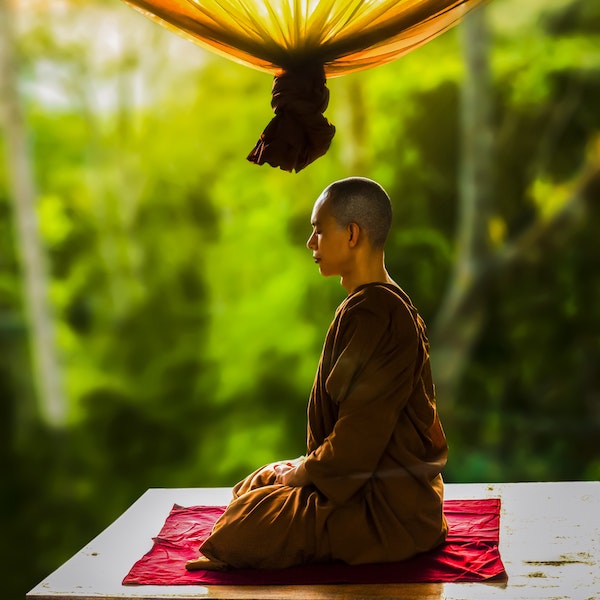
7 Buddhist Inspired New Year Resolutions & Mantras To Maintain Them
 Every year we make a new resolution for ourselves. We say we’re going to go to the gym more, or live more environmentally friendly. But year after year, we all too often fall off the wagon.
Every year we make a new resolution for ourselves. We say we’re going to go to the gym more, or live more environmentally friendly. But year after year, we all too often fall off the wagon.
So why is it so hard to keep resolutions?
And how can we adopt them into 2020 and beyond?
It’s not that we don’t want to be better people. It’s just that it’s often so dang hard to change our routines.
In the following guide you’ll find 7 Buddhist inspired New Year Resolutions, and mantras to help you integrated them into your life.
1) Towards Removing Frustration
According to Buddhism, frustration is an unhealthily attachment to people, things or outcomes we wish we could control but can not.
To help free yourself from this attachment, we recommend reciting the following mantra daily, “I will not set unreasonable expectations.”
2) Towards Removing Anger
Anger is an emotion innate to the human condition. We will feel angry sometimes, but we can learn how to express or even transform anger in ways that do not define us but rather assist us.
Towards changing the way we react to stressful situations, we recommend the mantra, “I can always choose how I respond to difficult situations”
3) Towards Removing Anxiety
Anxiety is best understood as a fear of the unknown. Anxiety has never been able to change one’s circumstance, only positive thoughts and actions can.
Towards removing a fear of the unknown, our recommended mantra is, “I have no reason to be anxious, everything always works out the way I want it to.”
4) Towards Being More Environmentally Mindful
Our planet is in need of our help more than ever before. While it’s true our individual impact may be small, our collective impact has the ability to make real change.
Buddhism has always advocated for the protection of the environment for one simple reason; compassion for others and for all living creatures.
Towards being more environmentally mindful, one of the most important things we can do is stop buying things that we do not need. This is also closely related to removing attachment and relieving suffering.
In this light, we recommend the mantra, “I already have everything I need to be happy.”
5) Towards Improving Physical Health
Many of us wish to work out more in order to attain a more desirable figure. In this sense, we are working out for others.
Instead, our primary motivation to work out should be to maintain good physical health. In this way, we are working out to love ourselves, and not seeking love from the external world.
We recommend the mantra, “I enjoy working out because it keeps my mind strong & clear.”
6) Towards Keeping In Touch
In our modern world many of us struggle to maintain healthy connections with friends and family. And this often leads to loneliness and depression.
To help keep you connected, we recommend actively sharing your fears, ambitions and that which your are grateful for with your loved ones. Our Everyday Enlightenment Journal presents a simple structure by which to do this.
Taking a verse from Chris McCandles, we recommend the mantra, “Happiness is only real when shared.”
7) Towards Being More Positive
To think bad thoughts is easy. If you leave your mind to itself it will spiral down into ever-increasing unhappiness. To think good thoughts however requires effort, discipline, & continual consciousness.
Towards maintaining a positive outlook, we recommend reciting this mantra daily, “Today I will make a conscious effort to replace negativity with positivity.”
Maintaining These Resolutions
All of the resolutions listed above require consistent effort. Reciting daily mantras help serve as an excellent strategy. Ultimately however, maintaining these resolutions require completely replacing old habits with new ones.
As humans, we are creatures of habit. We become addicted to certain routines and the emotions that come with them. It is therefor necessary to completely comprehend and acknowledge old habits in order to truly replace them. It’s easier said than done, but as the Buddha simply states, “Work hard to gain your own salvation.”
From all of us at Backpack Buddha in Nepal, Thailand, Guatemala and the USA, we hope 2020 will bring you the greatest inner peace, self love, discipline, and happiness on your path.
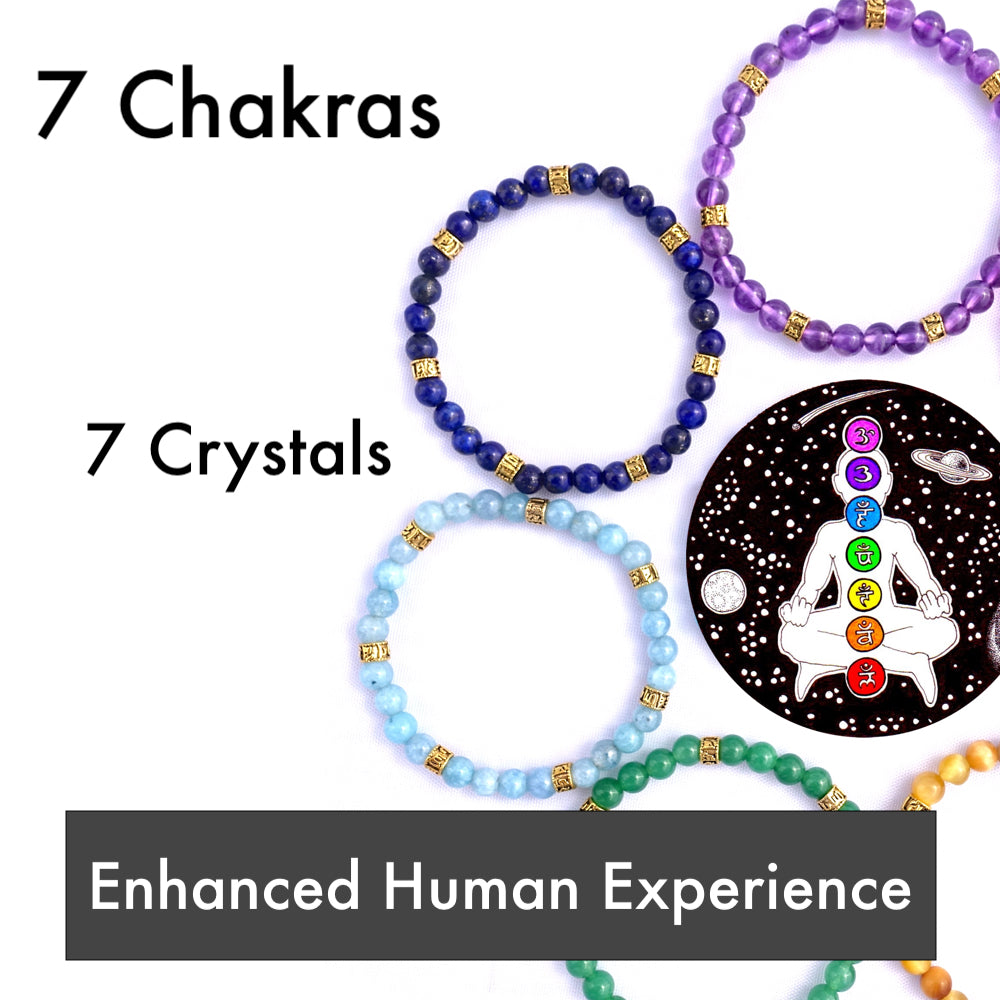
7 Crystals For 7 Chakras: How To Enhance Our Human Experience
 Enhancing the human experience means maximizing life force, managing emotions, balancing thoughts, and meeting the world as it appears in each moment.
Enhancing the human experience means maximizing life force, managing emotions, balancing thoughts, and meeting the world as it appears in each moment.
To get there, we must fine-tune all aspects of ourselves, without becoming overly dependent on any one of our tools, so that each is at our disposal at the right moment.
The chakra system provides us a means to identify, understand and hone each aspect of our being, so that we can dance with life as it unfolds.
One way in which we can better understand the chakras, and their pranic energy, is through the use of mother earth’s crystals. As the earth is in tune with the universal energy, so too are we.
Although the 7 Chakras can be harnessed towards enhancing our human experience without any supplement, the following crystals align too perfectly in both healing and empowering properties to be coincidental.
1.) Root Chakra - Muladhara - The Survivalist - Carnelian
Muladhara, is the foundation of the energy system, located at the base of the spine.
The word Muladhara literally translates to the “seat of the root,” or “root support,” and many modern practitioners call it simply “the root chakra.”
Muladhara governs our survival instincts, which means it is the energy of our basic fears. One of the most common manifestations of fear is anger. Recognizing the root cause of this fear and subsequent anger, leads to an ability to better tune into and utilize the Root Chakra in any situation.
The radiance of Red Carnelian along with its ability to calm anger and clarify perceptions makes it a crystal that seems to lend itself perfectly to the Root chakra. Focusing on this stone reminds us to always identify the root cause of our angers and frustrations.
2) Sakral Chakra - Svadhistana - The Hedonist - Tigers Eye
Svadhistana is typically referred to as “the sacral chakra,” due to its orientation in the area of the spine immediately above the sacrum (the five fused vertebrae above the tailbone). It is most commonly felt in the area of the genitals. For men, this is around the base of the penis, and for women around the clitoris.
As you might have guessed, the Sakral Chakra deals with pleasure and also creativity. Connecting with this Chakra requires courage and a deeper degree of self awareness. This is where Tigers Eye, with its strong confidence inspiring properties lends a hand.
3) Solar Plexus Chakra - Manipura - The Warrior - Yellow Tigers Eye
The Solar Plexus Chakra is felt in the belly, and has its root in the spine behind the belly button. As its location would suggest, it is associated with digestion.
It also concerns the energy of perseverance. When we are tired, sore, and the road ahead is strewn with obstacles, it is the energy of this chakra that we call on to make it through.
Yellow Tigers Eye, much like regular Tigers Eye, is another courage inspiring stone that seems to perfectly match the glow of the Sakral Chakra. When we focus on this stone we are not only reminded to fight on in the face of obstacles but to never give up.
4) Heart Chakra - Anahata - The Lover - Aventurine
Anahata is usually called “the heart chakra,” because it is located in the center of the chest, between the nipples, and its energetic qualities tend to also be associated with “the heart” in the poetic sense. This chakra deals with unconditional love, and can help us see the love in all of our decisions, including those that cause harm.
Green Aventurine is known as the heart healer. When we see Aventurine we are reminded of that which prevents us from loving unconditionally. But when we wear it, it’s feeling on our skin seems to translate inner peace, forgiveness, and a love for ourselves that helps us love others. This is why Green Aventurine is an ideal companion for the Heart Chakra.
5) Throat Chakra -Vishuddha - The Purist - Aquamarine
Vi meaning “high,” shuddha meaning “purity,” Vishuddha is the chakra of high purity, and that purity is reflected in each of its energetic attributes. It is located in the area of the throat, rooted in the cervical area of the spine, and known colloquially as “the throat chakra.” Its physiological counterparts are the thyroid and the parathyroid, which means that it plays a major role in governing the endocrine system.
The Throat Chakra enables us to communicate our truth openly, honestly, and clearly. It also enables us to perceive the truth in other’s expressions, even if it is masked.
The properties of Aquamarine are in perfect congruence with the throat chakra. It is a stone that is known to help one overcome judgement, and to promote self expression. It is also believed to help one overcome sore throats, swollen glands, and thyroid problems. It was as if Aquamarine was forged with the Throat Chakra in mind.
6) Third Eye Chakra - Ajna - The Visionary - Lapis Lazuli
Ajna is located at the very top of the spine. It is known as the Third Eye because it allows practitioners to access visionary states. This Chakra deals primarily with visualization and physic abilities. It is harnessed through an absolute clarity of mind, and increased wisdom.
Lapis Lazuli is ability to heighten awareness is believed by many to best enhance ones journey towards harnessing the Third Eye Chakra. It’s beautiful indigo color seems to reflects the serenity of the sky or ocean, making it a perfect stone to meditate on the Third Eye Chakra with.
7) Crown Chakra - Sahasrara- The Portal - Amethyst

Located at the crown of the head and representative of the point at which all differentiation is transcended into oneness, think of Sahasrara like a portal between divine oneness and our individual expressions.
One could say that it contains all energetic attributes of the former 6 chakras simultaneously.
Amethyst is helpful crystal to help better comprehend this final Chakra or “portal of oneness.” Amethyst seems to contain all the properties inherent to the 6 previous chakras. It is known to be soothing, balancing, confidence inspiring, loving, cleansing, truth speaking, and awareness enhancing.
Is The Chakra System Even Real?
Scientists have no idea what gravity is, only how it works. You can’t measure gravity itself, only its effect on objects. That doesn’t invalidate the theory of gravitation, because gravity’s effects are perceivable and predictable, and the experiments are reproducible.
Based on the reproducible results I’ve seen in others, and myself, I know that energetic practices, based on the chakra system, work. So, whether there is actually some measurable energy field around us (Google “Kirlian photography Burr and Ravitz” for scientific studies of the human aura), or if that is merely metaphorical language to describe something we don’t fully understand, is irrelevant.
If your goal is spiritual evolution, and enhancing the human condition, the chakra system is certainly a powerful tool to that end.
If you're looking for Chakra related crystals or jewelry, you can find it here, 7 Chakra Collection.
If you would like to learn more about the Chakras, please see, 7 Chakras: A Modern Guide To Ancient Wisdom.
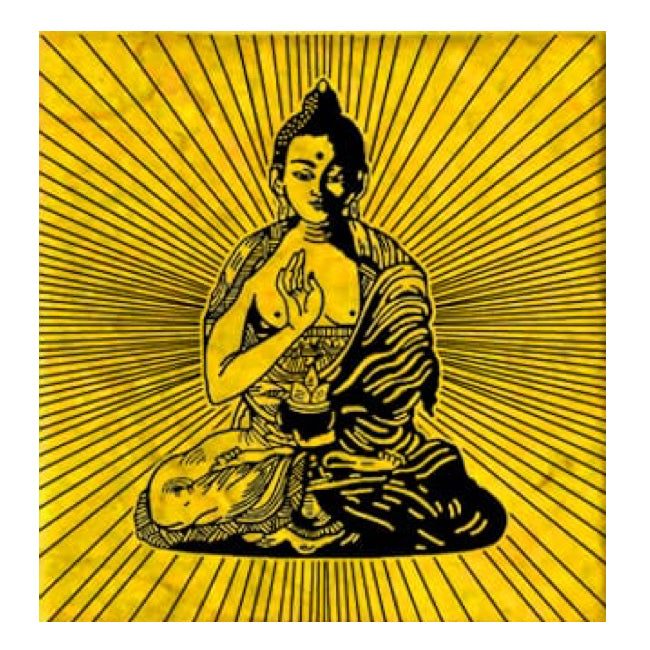
8 Enlightening Gifts For Beginner Buddhists
 Buddhism teaches us that the path to enlightenment, the end of suffering, is achieved by removing both emotional and physical desire. However, it also recognizes that removing all desire is not entirely practical in our physical world. It therefore prescribes the 8 fold path, known collectively as the Middle Way.
Buddhism teaches us that the path to enlightenment, the end of suffering, is achieved by removing both emotional and physical desire. However, it also recognizes that removing all desire is not entirely practical in our physical world. It therefore prescribes the 8 fold path, known collectively as the Middle Way.
Whether you or your loved one is a beginner of Buddhism or an aspiring yogi, below you will find 8 gifts specifically chosen to inspire and aid one along the Middle Way.
1) Everyday Enlightenment: Beginnings
 Everyday Enlightenment represents an excellent introduction to the definition of enlightenment as well as the 8 Fold Path. Throughout the 21 day self guided journey, one is inspired to reflect on the thoughts that most often result emotional pain. This in turn aids one at mastering the first 3 steps of Buddhism’s 8 Fold Path, Right Understanding, Right Thought, and Right Speech. Not only is the content enlightening, but the book, which is handmade from traditional lotkta paper and natural ink, is pretty special in itself.
Everyday Enlightenment represents an excellent introduction to the definition of enlightenment as well as the 8 Fold Path. Throughout the 21 day self guided journey, one is inspired to reflect on the thoughts that most often result emotional pain. This in turn aids one at mastering the first 3 steps of Buddhism’s 8 Fold Path, Right Understanding, Right Thought, and Right Speech. Not only is the content enlightening, but the book, which is handmade from traditional lotkta paper and natural ink, is pretty special in itself.
2) Monk Blessed Copper Mala

Mala beads, much like Rosaries, are meditational aids. They have been used for millennia to aid Buddhist monks master step 8, “Right Concentration,” or the practice of skillful meditation. Although one can use any type of Mala with 108 beads, this Mala is special in a few ways. First, it was infused with the positivity by the disciples of Lama Druthob Rinponch of the Woechen Thuk-Je Choeling Monastary in Nepal. Second, being hand carved out of copper, one can almost feel its conductive quality. The result is a Mala that wants to be recited upon, and that will hopefully last a lifetime.
3) Monk Blessed Rosewood Mala

This Blessed Rosewood Mala is much lighter than the Copper Mala featured above. This means, that with its adjustable cord, it can be worn comfortably at any time. It is made from the highest quality Indian rosewood, which gives it a beautiful grain. Like the Copper Mala, it also comes in a hand carved rosewood box. The box contains two small scrolls that give details about the mantra used to bless it.
3) Monk Blessed Conchshell Mala

The final Mala we would like to recommend in this guide is this natural Conchshell Mala. The photos speak for themselves, but this truly is a beautifully crafted Mala. Like the former two Malas, this one also includes the rosewood box, as well as the donation to the Monastery. Again, the scrolls found inside the box, are quite unique and explain the blessing process, making it a remarkable gift for anyone interested in Buddhism.
4) Traditional Mandala Incense

These incense will transport you right into the halls of a Buddhist monastery. It is made in Nepal out of all natural seeds, roots, resins, flowers, and barks. It is a distinct and soothing smell, and one that somehow inspires meditation. The bamboo and traditional paper packaging is pretty unique and eco-friendly as well.
5) Singing Bowl Sound Healing

Scientists have postured that the high-intensity, low-frequency combination of singing bowls, can induce a deep relaxation response and positively affect mood and sense of well-being. And in our experience we have definitely found this to be true. Made in Nepal, this bowl is small and portable, making it great for a little pre-meditation sound healing at home or on the go.
6) Monk Blessed Silver Om Ring

We love this ring because it fits perfect, is handmade out of sterling silver, and is engraved with the ancient mantra, Om Mani Padme Hum. The the ring and the mantra are a constant reminder to maintain the “Right Mindfulness” of one’s feelings, body and mental outlook. Like the Malas, it is also blessed, and comes in an original handmade jewelry container.
7) Every Night Enlightenment

was developed to help people sleep through Buddhist breathing techniques and 8 Fold Path inspired nightly exercises. Like Everyday Enlightenment, this is a 21 night self guided journal made from traditional lokta paper. It’s an excellent gift for both insomniacs and aspiring Buddhists alike.
8) Buddha Bear’s Enlightenment Coloring Book

Buddha Bear was brought to life by celebrated author and cartoonist Guy Gilchrist. It is arguably the cutest character ever created. Over the course of 21 days, you’ll travel with Buddha Bear, learning Buddhism inspired lessons, and coloring along the way. It is truly a unique and memorable coloring book.
Conclusion
The gifts in this guide all designed to inspire and empower aspiring Buddhists. But they are also ideal for advanced practitioners as well.
More, all of these products have been handmade in Nepal, which means a percent of the profit goes to supporting livelihoods there.
For more info about Backpack Buddha, the causes they support, and how their products are made, check out this about page here, About.

7 Mantras For Modern Life
 Recitation, whether it be of prayers, truths, or mantras, is a powerful form of meditation. It is a practice that can meaningfully shape our reality for the better.
Recitation, whether it be of prayers, truths, or mantras, is a powerful form of meditation. It is a practice that can meaningfully shape our reality for the better.
With the help of ancient Buddhist mantras, we’ve developed 7 easy yet effective modern mantras. *If you own a Mala, we encourage you to recite these mantras108 times on each bead.
The goal of these mantras?
To live free from fear & stress.
To live a life of peace & contentment.
*The following mantras are just a few contained in our popular self guided journal, Everyday Enlightenment: Beginnings
1. To combat negative thoughts:
“Today I will make a conscious effort to replace negativity with positivity. ”
To think bad thoughts is easy. If you leave your mind to itself it will spiral down into ever-increasing unhappiness. To think good thoughts however requires effort, discipline, & continual consciousness.
2. To help avoid frustration
“I will not set unreasonable expectations”
Frustration is an unhealthily attachment to people, things or outcomes we wish we could control but can not. Let us free ourselves from stress by removing attachment to outcomes we can not control.
3. To help manage anger
“Anger is a response I can choose not to use”
Anger is an emotion innate to the human condition. We will feel angry sometimes, but we can learn how to express or even transform anger in ways that do not define us but rather assist us.
4. Towards overcoming lonliness / a feeling of disconnection.
“We are all connected in suffering and joy.”
We all experience loneliness. It is a feeling that connects us all. The great thing about loneliness is that it always passes. So remember, be kind to yourself in the meantime.
5. Towards alleviating anxiety
“I have no reason to be anxious, everything always works out the way I want it to.”
Anxiety is best understood as a fear of the unknown. Anxiety has never been able to change one’s circumstance, only positive thoughts and actions can.
6. For managing the difficulties of everyday life.
“When life feels hard I always overcome.”
Life is suffering. However, it is only through suffering that we learn to adapt and grow. It is only through suffering that the Buddha attained enlightenment. Embrace the difficulties of life.
7. To alleviate fear
“My fears are only as strong as I allow them to be.”
Everyone is often so worried about their own fears and problems they couldn’t care less about yours. The less you fear, the less you realize you need to fear.
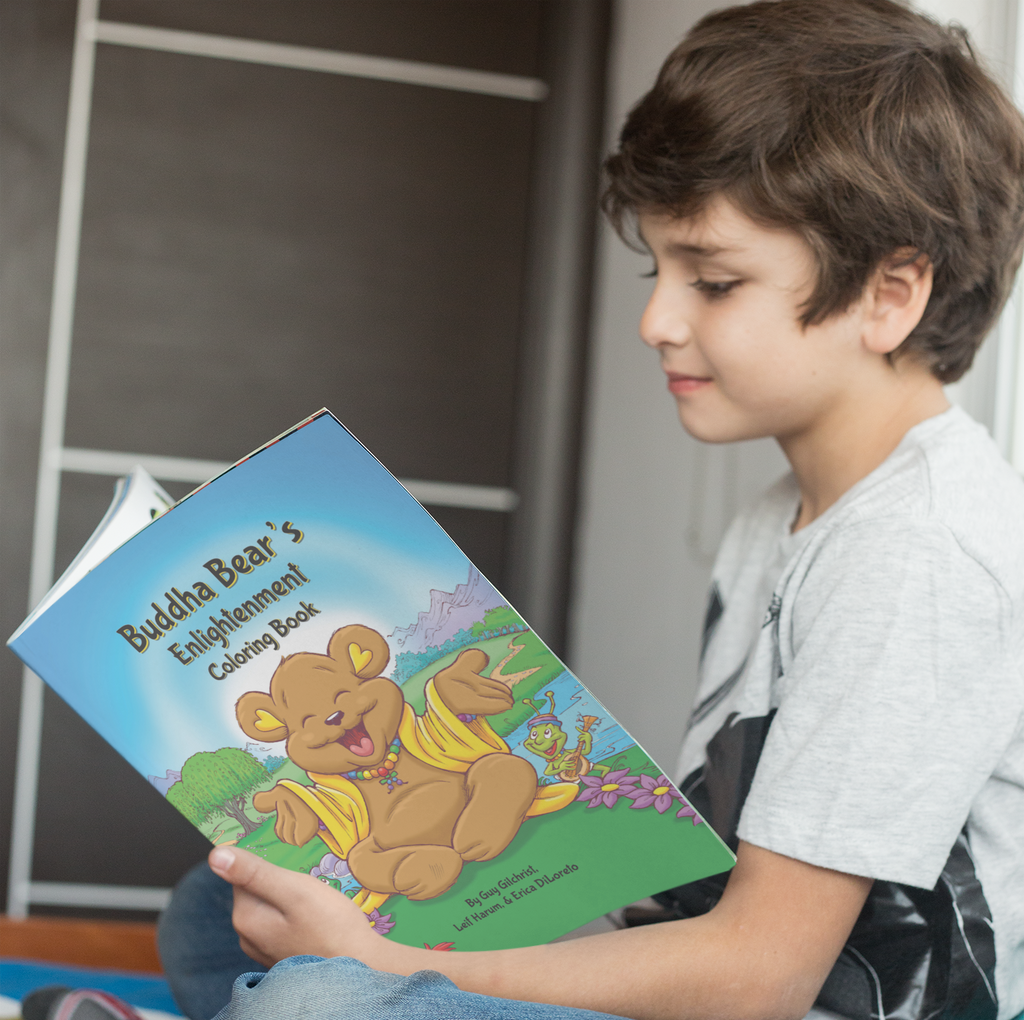
Buddha Bear: Towards Emotional & Spiritual Enlightenment For Kids
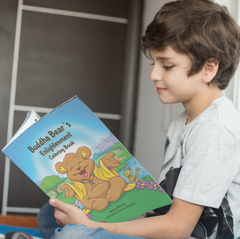 More so than ever before, our kids are growing up fast. Smart phones and connected devices are increasingly exposing our children to mature themes; from growing climate instability to morally corrupt leadership. Such topics can often negatively influence our children’s worldview and subsequently, their emotional well being.
More so than ever before, our kids are growing up fast. Smart phones and connected devices are increasingly exposing our children to mature themes; from growing climate instability to morally corrupt leadership. Such topics can often negatively influence our children’s worldview and subsequently, their emotional well being.
Therefore, it is vital for us, as parents, to present our kids with resources that are both entertaining and morally wholesome. Towards this goal, celebrated author and cartoonist Guy Gilchrist, together with the team at Backpack Buddha, have developed a very unique interactive children’s book entitled, “Buddha Bear’s Enlightenment Coloring Book.”
Although the book draws it’s strength directly from Buddhism’s 8 Fold Path, it is largely a non-denomination journal. In other words, anyone of any faith can easily relate and benefit from this book. And while this book is primarily intended for kids aged 5-12, that doesn’t mean you can’t enjoy and benefit from this coloring book as well!
It’s primary aim, to foster positive spiritual and emotional growth through concepts of compassion for others, gratitude for nature, and love for one’s self.
Spiritual Growth Though Buddhism’s 8 Fold Path For Kids
The strength of this coloring book lies in its incorporation of Buddha’s 8 Fold Path; 8 paths one should take to achieve Enlightenment.
- 1. Right View or Understanding: To gain insight into the true nature of reality.
- 2. Right Intention: The unselfish desire to realize enlightenment.
- 3. Right Speech: Using speech in compassion & kindness.
- 4. Right Action: Striving towards ethical conduct and compassion.
- 5. Right Livelihood: Making a living through ethical means, and living without negative things such as drugs or alcohol.
- 6. Right Effort: Cultivating positive qualities and releasing negative ones.
- 7. Right Mindfulness: To always be thinking, aligned in body and mind.
- 8. Right Concentration: Meditation through mantras or through breathing.

How does this book incorporate the 8 Fold Path?
Similar to Backpack Buddha’s popular adult publication “Everyday Enlightenment,” Buddha Bear’s ECB also consists of 21 days. Each day is inspired by one of the 8 paths of the 8 Fold Path.
Day 18 revolves around path 2, cultivating the right intentions or thinking. To begin, young readers discover a insightful quote which reflects the day’s theme. The quote for this day comes from Lao Tzu, “When you accept yourself, the whole world accepts you.” Simple, yet powerful and always so true.
Next, the reader is introduced to the daily adventure of Buddha Bear. On “Day 18,” the theme revolves around self-love and acceptance. Here, Buddha Bear tell us, “You know, even though I look different from some of the other travelers, I love the way I look because no one else is the same as me! My belly is big and I’m not that tall, but I sure do find the best places to sleep!” Here Buddha Bear accepts his differences, and derives confidence from them.
The reader is then promoted to respond to a question of self reflection. Continuing with “Day 18,” Buddha Bear asks, “What do you like about the way you look?” Ultimately, this forces the reader to reinforce their positive self image by writing it down in indelible ink.
Finally, readers can then color in a content looking Buddha Bear as they reflect on the days theme.
Overall, the layout is simple, yet incredibly effective in it’s approach. It takes often ambiguous and difficult to understand concepts from the 8 Fold Path, and presents them in a way children can truly practice and benefit from.
Inspiring Gratitude For Nature
Throughout the book, Buddha Bear deals with many themes associated with an appreciation for nature. By doing so, it aims to inspire kids to not only get outside and play, but also protect our natural world, which is increasing under threat from anthropogenic climate change. More, the book itself is made entirely by hand from sustainable lokta paper.
About The Creator Guy Gilchrist
Guy Gilchrist is perhaps best known as Jim Henson’s cartoonist. However, he is also an acclaimed author and illustrator of over 60 children’s books, three of which were awarded best book of the year by the United Nations International Reading Council. As a result of his long and illustrious career, his work has been permanently enshrined in the National Smithsonian Institute.

Conclusion
Buddha Bear’s Enlightenment Coloring book is full of powerful exercises in compassion, self realization, and appreciation for nature, that are directly inspired by Buddha’s 8 Fold Path. The incredibly cute stories and illustrations by Guy Gilchrist makes it a joy to read and color for any child and parent, regardless of religion. All of this makes Buddha Bear’s Enlightenment Coloring book remarkably unique, and unrivaled among todays children’s books on the market.

A Comprehensive Guide To Meditating With A Buddhist Mala
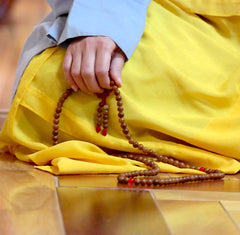 Mala Beads are ancient. Yogis and Buddhist Monks have been reciting prayers or mantras on their 108 Mala beads for millennium. In Buddhism, the Mala is used to help achieve the 8th step of Buddha's 8 Fold Path, "Right Concentration." It is believed that only through the right concentration that we can understand and thereby liberate ourselves from suffering.
Mala Beads are ancient. Yogis and Buddhist Monks have been reciting prayers or mantras on their 108 Mala beads for millennium. In Buddhism, the Mala is used to help achieve the 8th step of Buddha's 8 Fold Path, "Right Concentration." It is believed that only through the right concentration that we can understand and thereby liberate ourselves from suffering.
If you've heard about Mala meditation, but have know idea where to start, you're in the right place. In the following guide you'll learn everything you need to know about Mala beads, how to choose a mala that's right for you, and how to meditate with them.
Why Does The Buddhist Mala Have 108 Beads
Although the reason for 108 beads is contested, it is certainly a spiritually significant number, and one found throughout Hindu and Buddhist traditions. In Hinduism, there are 108 Upanishads, ancient texts from spiritual sages. There are also 108 revered Hindu goddess. In Buddhism, there are 108 earthly desires that must be overcome to achieve enlightenment. Finally, some people have found the number 108 significant in astrology where the multiplication of 12 houses and 9 planets equals 108. Whatever the case, there is no doubt that 108 beads holds great significance across Hindu-Buddhist religions.
How To Choose A Buddhist Mala
When choosing a Buddhist Mala, it is important to consider a few different things.
- Bead Size: Whichever Mala you choose, you're going to want to make sure that the beads feel comfortable and even calming between your fingers. A good size for those with smaller fingers is 6 or 7mm round beads. For people with larger fingers, 8 to 10mm is recommended. Of course, this doesn't means 12 or even 14 mm bhodi seeds are out of the question, as many monks often count on these as well.
- Bead Texture: Some people prefer the energy transference of a metal Mala, the texture of a conch shell mala, or even the properties of crystal mala beads. Others find wooden mala beads the most satisfying to roll. And there are those that prefer prickly rudraksha seed Mala beads.
- Mala Weight: The Buddhist Mala is often adjustable and worn around the wrist. If you prefer something lighter, wood is your best option. For a more substantial feel, copper, brass, conch shell or crystals are preferred.
Overall, it's a good idea to test each type of Mala before committing. Discover which one speaks to you the most to and your unique energy. For a collection of wearable meditation Mala beads, you’ll find our collection here. We always offer returns, and strive to treat every customer the way we would want to be treated.
Blessing Your Buddhist Mala
In countries like Nepal with strong Buddhist traditions, it is common to have a new Mala blessed by monastic monks. The senior monk purifies and infuses the Mala with positive energy through the ancient mantras such as “Om Ranchi Ramni Tawa Taya Hum.” For more information about blessed Malas, please view our Blessed Mala Collection.
How To Use A Buddhist Mala
Although Buddhist Mala beads are used by monks during meditation, they can also be used throughout one's day. Countless Nepali often wear their Mala loosely on their left wrist. When they are waiting on line, they count their beads. When they feel anxious or stressed, they roll the beads to induce calm.
However, when it comes to meditation, there is a specific method by which to use your Mala.
- First, hold your Mala in the left hand (the receiving hand) between the index or middle finger and thumb.
- Grasp the Mala gently but with intention.
- Take a few natural breaths and begin.
- Start counting with the first bead after the guru bead.
- Count one bead for each completed recitation, affirmation or mantra.
- Continue this for 108 beads.
The Best Mantras For Mala Meditation
Traditional Buddhist & Hindu Mala Meditation Mantras:
- OM MANI PADME HUM – the six syllables, Om Ma Ni Pad Me Hum (ohm) (mah) (nee) (pahd) (may) (hum) This mantra is considered to be the sound of truth; truth in purity, truth in the path, and truth in compassion. It is literally translated to the jewel in the lotus flower towards enlightenment. In other words, it is believed that by reciting this mantra one becomes closer to attaining enlightenment. It is an ancient mantra surrounding the bodhisattva of compassion or Avalokiteshvara. Since the Dalai Lama is considered to be an incarnation of Avalokiteshvara, this mantra is his. It is also the most widely used of all Tibetan Buddhist Mantras.
- OM AMI DEWA HRIH - Om Ami Dewa (ohm) (am e) (De Wa) Hrih (Shri) This mantra is believed to protect one from dangers and obstacles, and help you to overcome hindrances to your success.
- The 108 Names Of Buddha - In many Buddhist temples and monasteries, the names of Buddha are often recited while counting Mala beads. Om budhaaya namah, Om budhaarcitaaya namah, Om saumyaaya namah, Om saumyacittaaya namah, Om shubha-pradaaya namah (Buddha has a lot of names!)
- OM NAMAH SHIVAYA - Om Namah Shivaya (ohm) (Na ma) (Shi Va Ya) is one of the most popular Hindu mantras and the most important mantra in Shaivism (Worship to the God Shiva). It is often translated to mean “I honor The God Within me,” which is a pillar of Hindu dogma.
Unique Mantras For Modern Life
The ancient mantras hold great meaning and power, but we tend to gravitate towards mantras in English that are more relatable. Remember, if you’re making your own mantras, always be sure to make them in the present tense, as opposed to the future. We find that present tense mantras are often more powerful and immediate. Here are some of our favorites that we like to recite:
- I believe in the power of cause and effect
- I create whatever reality I desire I am enough
- I am the best version of myself
- I love the divine within everyone I meet
- As long as I have love I have no need to fear
- In order to love myself I practice loving others
- I trust in the god within me
- I am grateful for all that I have and all the people in my life
- I never give up
The Best Way To Meditate With A Mala
One of the greatest aspects of Hinduism and Buddhism is that they are religions open to great interpretation. Although Buddhism and Hinduism offer guidelines and paths towards enlightenment, in the end, it is up to you to strive towards your own enlightenment.
As the Dalai Lama once stated, “This is my simple religion. There is no need for temples; no need for complicated philosophy. Our own brain, our own heart is our temple; the philosophy is kindness.” In other words, it all boils down to kindness, compassion and the cessation of suffering, and you can decide exactly how you want to use your unique Mala towards this end.
You can create a custom mantra specific to your struggle. You can simply count your breaths as you count the beads. You can also just wear them, and in doing so remember to become more mindful, grateful and compassionate each time you see them.
However, as with any endeavor, especially one as challenging as enlightenment, it is important to remain disciplined and dedicated. If you start reciting your own mantras, make it a habit. Recite once when you wake up and once before you go to sleep. Recite when you feel stressed or restless. Recite whenever you feel the need. From all of us at backpack Buddha, we wish you the greatest peace, love and contentment on your path.
- 1
- 2
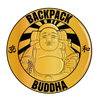




 Life Isn't Always easy...
Life Isn't Always easy...







